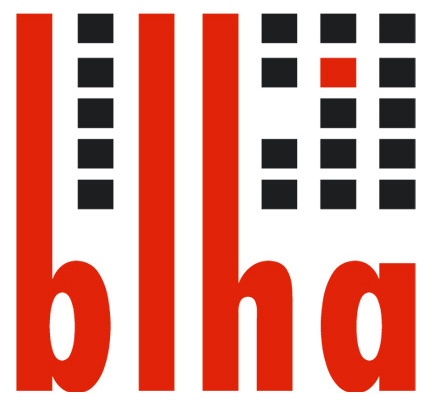Notes on researching the files Rep. 36A Oberfinanzpräsident Berlin-Brandenburg (II)
Development and handling of compulsory names
During the cataloguing of the collection, the compulsory names were not recorded due to their discriminatory character. When using the fonds for publications and projects, the forced names should not be used in order to prevent the reproduction of perpetrator terminology.
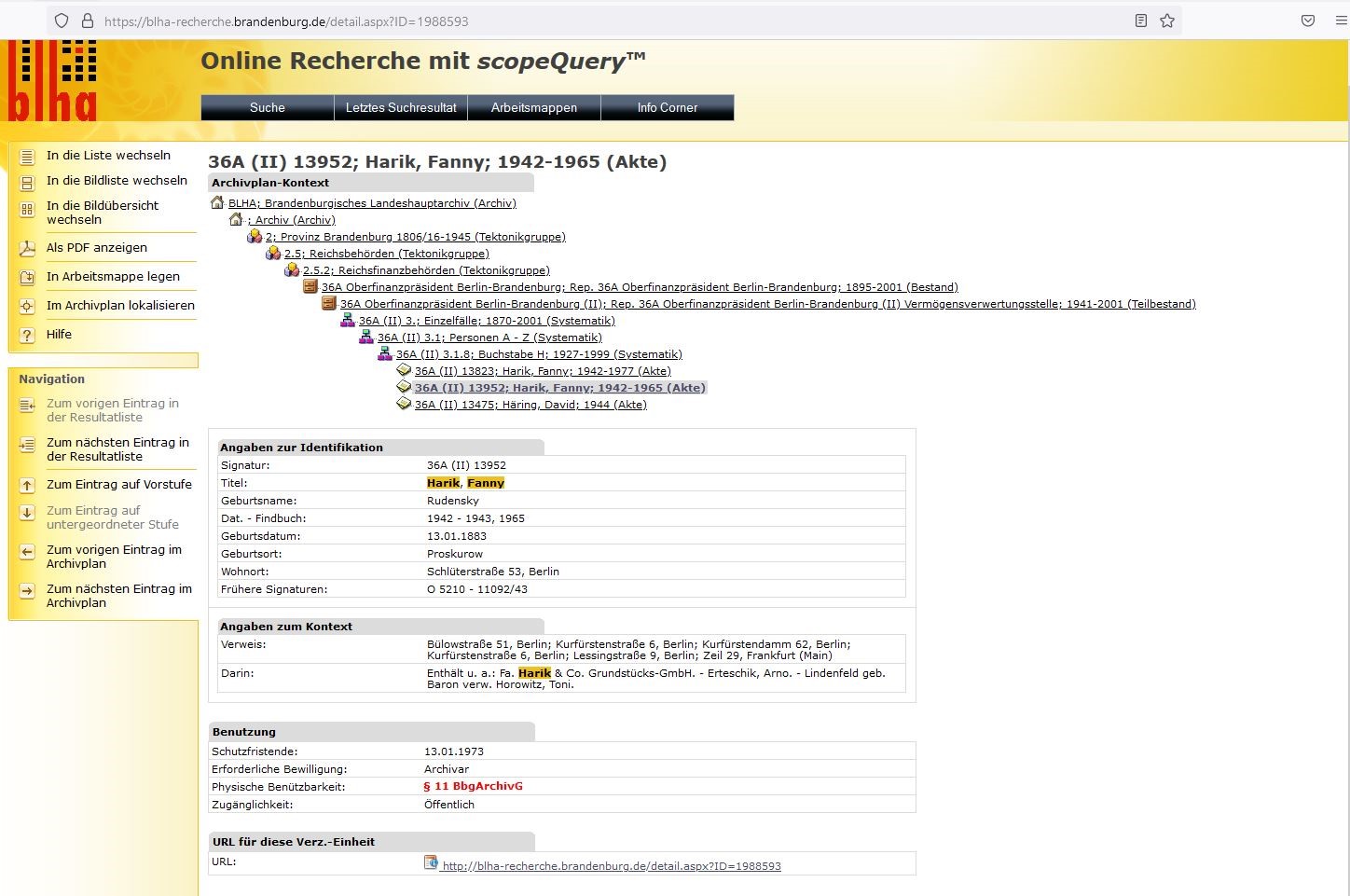
ALT TEXT: Fanny Harik record contains surname, maiden name, date of birth, place of birth, address, companies, terms of protection and a permalink to the record.
Figure 1: Example data set with all data fields released for use.
Explanation of the individual data fields
Title
The title is usually formed by the name of the main person in the file. The names that form the title of the file are made up of ‘surname, first name’.
Widowed, remarried women for whom a ‘widowed + surname marriage 1’ was added after the surname are a special case. The maiden names of married women listed in the title were recorded in the ‘maiden name’ field.
A further exception is estate files that were kept for communities of heirs. Here, the name of the deceased and a ‘- estate’ added after a hyphen form the title. The persons affected by the probate matter are recorded in the ‘Contains note’.
In the case of several spellings of a name, e.g. Elisabeth, Elisabet, the spelling that occurs most frequently in the file has been recorded as the main name. All others are listed in round brackets ‘()’ after the main name, e.g. Elisabeth (Elisabet). Nicknames or nicknames are also recorded in the round brackets.
Date-findbook
The duration indicates the year of the oldest and most recent document in the file. The year separated by a comma refers to the most recent document of the documents added to the file after 1945. The years from 1945 onwards provide an indication of any documents relating to compensation or restitution proceedings.
Date of birth
The date of birth is recorded in the format dd.mm.yyyy
Place of birth
The places of birth were adopted according to the spelling in the records. Special characters from Polish, Hungarian, Czech etc. were not taken into account, e.g. Długa = Dluga; Przemyśl = Przemysl.
When researching, please bear in mind that places changed names within a short period of time. It is therefore possible that one person gave their place of birth as Hindenburg and another as Zabrze. Both place names refer to the same town. The decisive factor here is whether the person in question was born before or after 1915. All place names should therefore always be included in the research.
In the case of place names that exist more than once, the place suffix was recorded – if indicated in the file. River names were added in round brackets, e.g. Frankfurt (Main) or Frankfurt (Oder). Landscape names or regional names after a ‘/’ e.g. Katy/Galicia or Strasburg/West Prussia.
Place of residence
The Place of residence field lists all the places of residence that could be determined for a person based on a comparison of existing addresses in the indexing data and the residential addresses recorded in the Berliner-Gedenkbuchdatenbak. These may include the places of residence of the person listed in the title over several years or decades.
The street spelling is based on the generally accepted street names at the time the file was created. An overview of the different spellings and changes in naming can be found in the directory of historical street names in Berlin: https://berlingeschichte.de/berlinaz/indexabz.htm or in Kaupert’s street guide through Berlin: https://berlin.kauperts.de/.
The generally accepted abbreviation for streets, ‘Str.’, has been removed from all of the sub-collections of the Asset Realisation Office.
Addresses comprising several house numbers were standardised in such a way that the most commonly used spelling from the files was transferred to the same address. Occurring spellings are those with a hyphen ‘/’ and a hyphen ‘-’, e.g. Brunnenstraße 10/12 or Braunauer Straße 216-218.
As it is quite possible that persons for whom files were kept in the Asset Realisation Office of the OFP Berlin-Brandenburg also had previous residences outside Berlin, the corresponding place name was recorded after the address, e.g. Braunauer Straße 216-218, Berlin or Grüne Wiese 23, Guben.
Volume numbers
For multi-volume files: Number of the file volume in Roman numerals.
Former shelfmarks
The file numbers assigned in the Asset Realisation Office are recorded in the fonds Rep. 36A (II) under ‘Former shelfmarks’. They provide a rough indication of whether the person for whom the file was created was able to leave Germany or was deported to a concentration or extermination camp in the course of the deportations.
O 5205 –
According to the 1938 file plan of the Reich Ministry of Finance (RMF) for assets ‘confiscated in favour of the Reich.’ From 1941 de facto for deported persons. The file numbers of file group O 5205 generally follow a fixed scheme.
The file number O 5205 – is followed by the number of the deportation wave (caution: not the transport number). This was done in Roman numerals up to deportation wave 30 (e.g. XV for the age transports 4-8 to Theresienstadt in the period from 9 June 1942 to 19 June 1942). From wave 31 onwards, the numbering was continued in Arabic numerals. This is followed by a ‘/’ and a consecutive number in Arabic numerals assigned by the registry in the Asset Realisation Office.
Here are two examples: O 5205 – XXV/13195 refers to the 25th transport wave and therefore to the 18th eastern transport to Riga and the 44th old-age transport to Theresienstadt. O 5205 – 48/30498 refers to the 48th transport wave and therefore to the 34th eastern transport to the Auschwitz concentration and extermination camp.
If you are looking for files relating to a specific deportation wave, use the following search query ‘O 5205 – wave number’. Caution: There are minor exceptions to this rule, but they do not follow any identifiable scheme. You can access the digital copies of the transport lists via the online archive of the Arolsen Archives at https://collections.arolsen-archives.org/en/archive/1-2-1-1_VCC-155-I. The names can also be researched there.
Special file number O 5205
In addition to the standard file number, there are other file numbers with a special meaning:
O 5205a – +consecutive number
Special file number for so-called ‘enemies of the Reich’. The files kept under this file number relate to a very heterogeneous group of people to whom the 11th Ordinance could not be applied. This includes, for example, political opponents of the Nazi regime, Eastern European forced labourers or stateless persons. In the case of secret files, a small ‘g’ is added after the consecutive number.
An example: O 5205a – 15
The BLHA has its own finding aid for all Reich enemy files under Rep 36A Oberfinanzpräsident Berlin-Brandenburg (II) No. 55204.
O 5205 – ‘T-’ + consecutive number
This concerns persons who died after the enactment of the 13th preliminary regulation to the Reich Citizenship Act. This regulation considerably simplified access to estates.
An example: O 5205 – T-315
The Landeshauptarchiv has a separate finding aid for this with the shelfmark Rep. 36A Oberfinanzpräsident Berlin-Brandenburg (II) No. 55265.
O 5205 – Sm-+Wellennummer/+Fortlaufende Nummer
This file number refers to persons who escaped deportation by fleeing or committing suicide. There are several spellings of the file number on and in the files, e.g. Sm-+Wellennummer/+Fortlaufende Nummer; Sm+Wellennummer/+Fortlaufende Nummer; Sm-+Wellennummer/+Fortlaufende Nummer. To standardise the information, the file number has been adopted as above.
An example: O 5205 – Sm-60/36609
The lists of the Gestapo in which the Asset Realisation Office was informed which persons evaded deportation by going into hiding or committing suicide are incompletely preserved in the State Main Archives under Rep. 36A Oberfinanzpräsident Berlin-Brandenburg (II) No. 56000-56004.
O 5025 – Erm+consecutive number
This is a file in which the documents received first had to be assigned to a case by the registry. This was carried out by the Investigation Department, which provisionally assigned this file number. Cases that could not be assigned to a file number retained the provisional file number.
An example: O 5205 – Erm-6972
O 5205 – Zg-+consecutive number
This file number is a temporary file number and identifies processes that were first recorded in the registry. A regular file number was usually assigned later. File numbers created in this way are the exception.
O 5210 –
According to the 1938 file plan of the Reich Ministry of Finance (RMF) for assets ‘declared forfeited in favour of the Reich.’ From 1941 de facto for emigrants and estates/communities of heirs. This is followed by a consecutive number and the year of asset forfeiture separated by ‘/’. The consecutive number starts again at 1 for each year.
An example O 5210 – 11092/43
File number of the Moabit-West tax office S 1110 and O 1300
In addition to the file numbers assigned by the Asset Realisation Office at the OFP Berlin-Brandenburg, there are still remnants of file numbers assigned by the Moabit-West tax office. The file numbers S 1110 and O 1300 are precursor file numbers of O 5210 and are structured in the same way. In April 1941, the majority of the two file numbers were exchanged. Only a small number of expatriation procedures have retained this file number.
Contains note
Names
Names were recorded according to the spelling of the names in the files. In the ‘contains’ note, the name of male persons is formed as in the title. For married females, ‘surname born maiden name, first name’. If you are looking for female persons, search both with and without maiden name. If a woman is also widowed, the maiden name is given first and then the widowed name, e.g. Friedländer, née Grün, widowed Schmid, Margarete.
Companies
Companies, corporations, joint-stock companies, banks and commercial enterprises are indicated in the ‘contains’ note with a ‘Fa.’ in front. The spelling of the above is taken from the files. Deviations from the names entered in the commercial register etc. are therefore possible. Companies without a city suffix were generally located in Berlin.
Names and companies are separated by the character string ‘. -’ from each other.
Reference
All other addresses associated with the file are recorded here. This includes the property of the person from the main file, business addresses, but also addresses of other persons named in the file or the ‘contains’ note.
Research examples
Full text search personal names
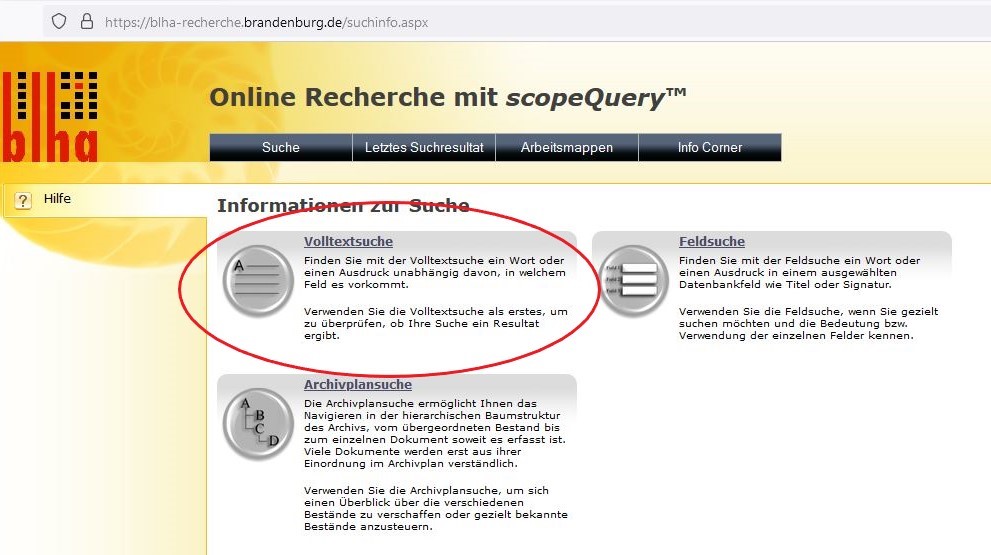
ALT TEXT: Scope Query start page with the three search functions full text search, archive plan search and field search, the full text search is highlighted:
1. Open the online search of the Brandenburg State Archives at https://blha-recherche.brandenburg.de/suchinfo.aspx and select the full text search.

ALT TEXT: Full text search with example search for Martha Liebermann in highlighted search field
Enter the name of the person you are looking for in the search slot. The form of the entry is not relevant for this search.
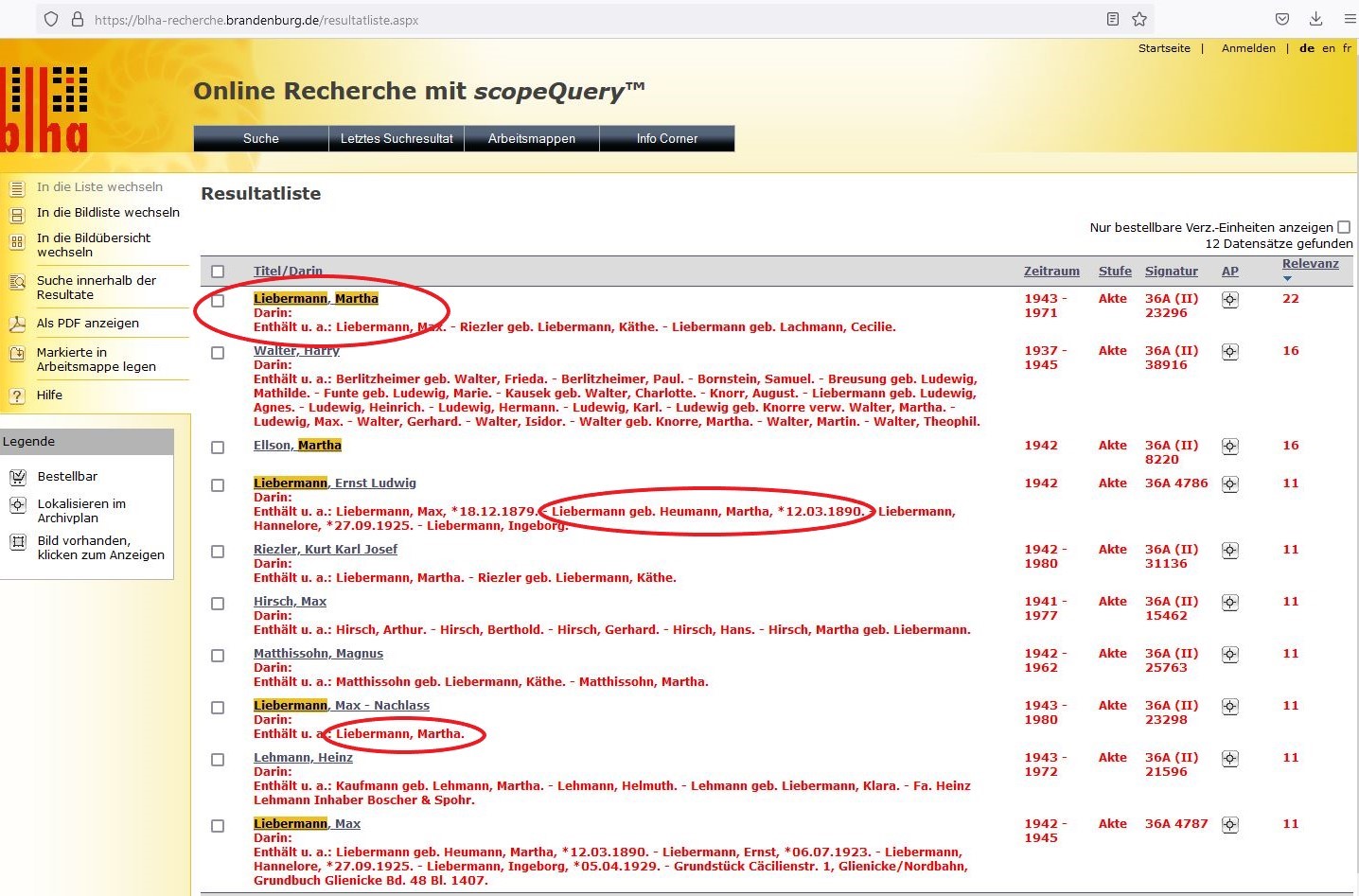
ALT TEXT: Hit list with the name Martha Liebermann, in the list the title, beginning of the contains note, duration and signature are visible
All entries containing ‘Liebermann’ and ‘Martha’ in any field will be found. To view a record in more detail, simply click on the title.
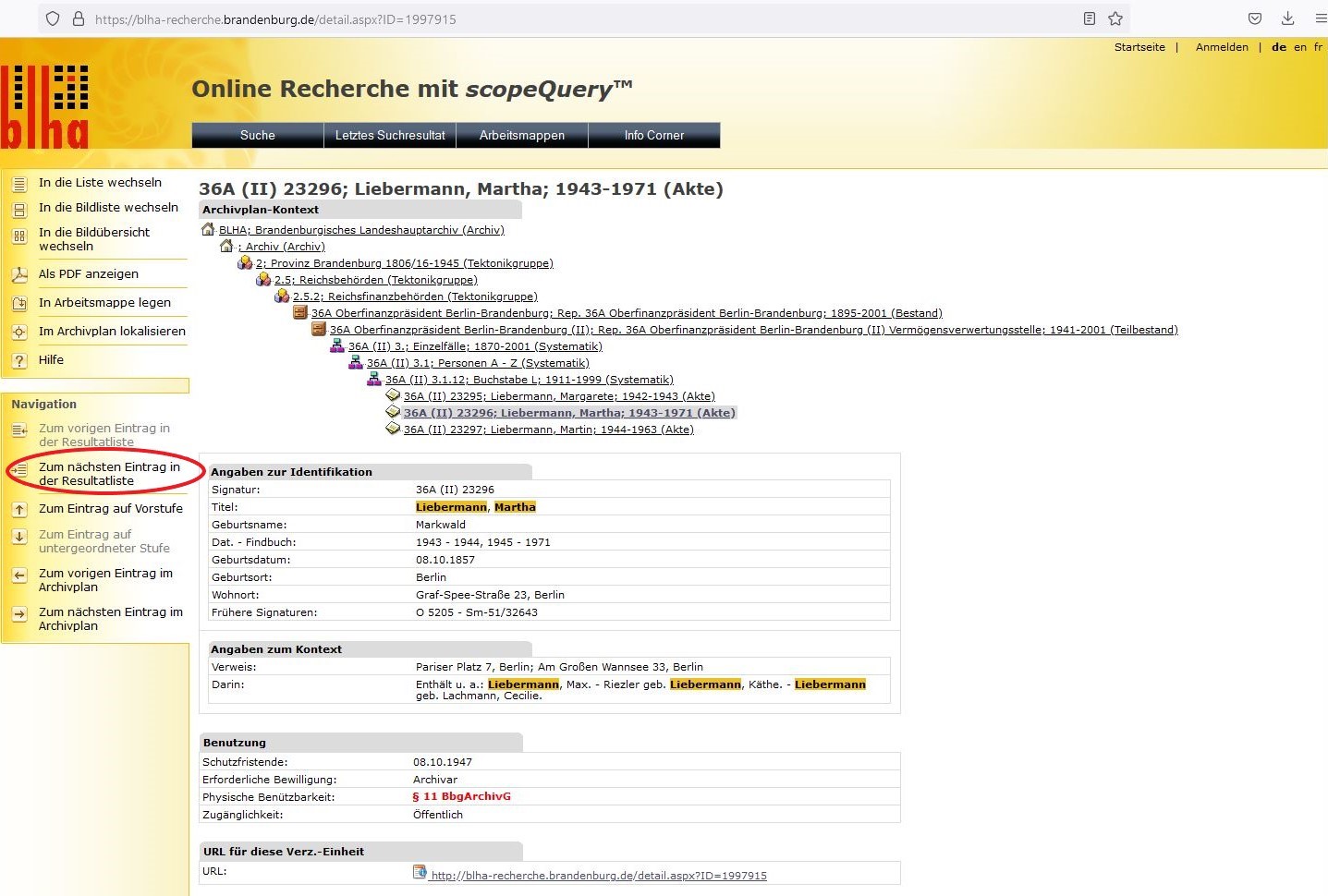
ALT TEXT: Highlighting the ‘Go to next entry in the results list’ function in the margin column on the left
In the detailed view, you can check whether this is the person you are looking for. If the data record called up does not match the person you are looking for, you can use the navigation bar on the left-hand side to look through the search results from the hit list.
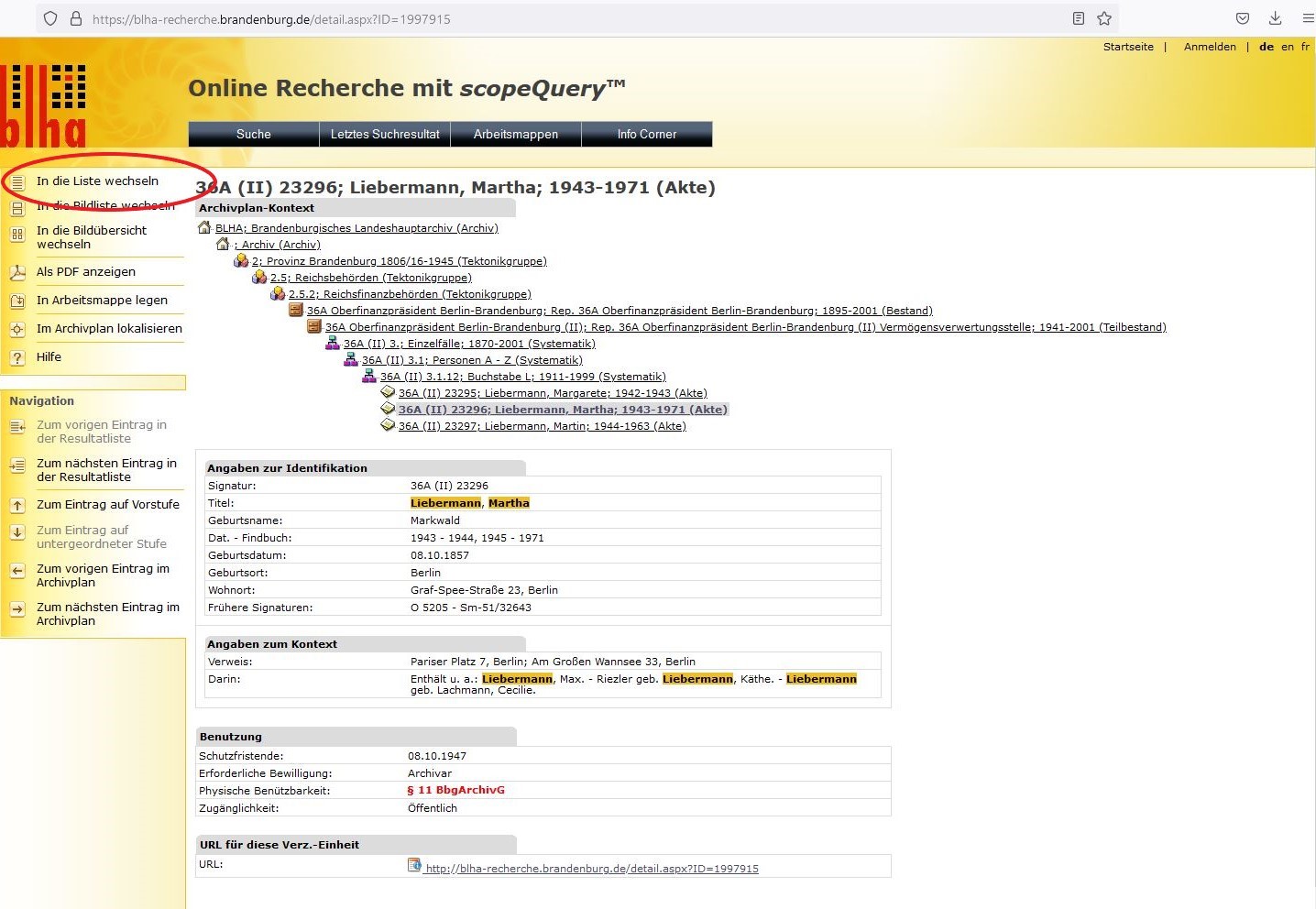
ALT TEXT: Highlighting the ‘Switch to list’ function in the margin column on the left
If you do not want to click through a large number of hits entry by entry, you can refine the search. To do this, first switch back to the list view via the navigation bar on the left.
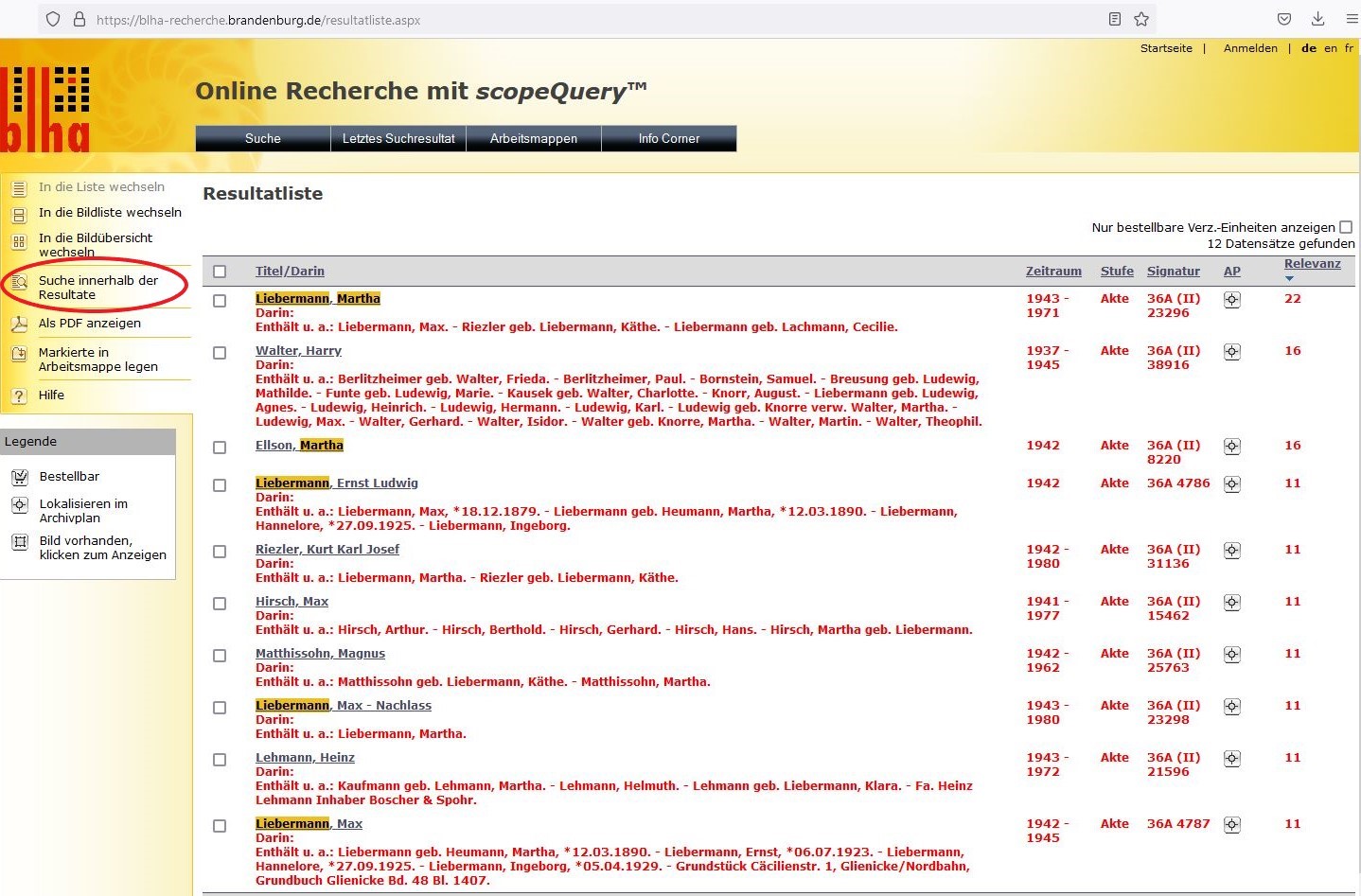
ALT TEXT: Highlighting the ‘Search within the results list’ function in the margin column on the left
You can then initiate a ‘Search within the results list’ via the navigation.
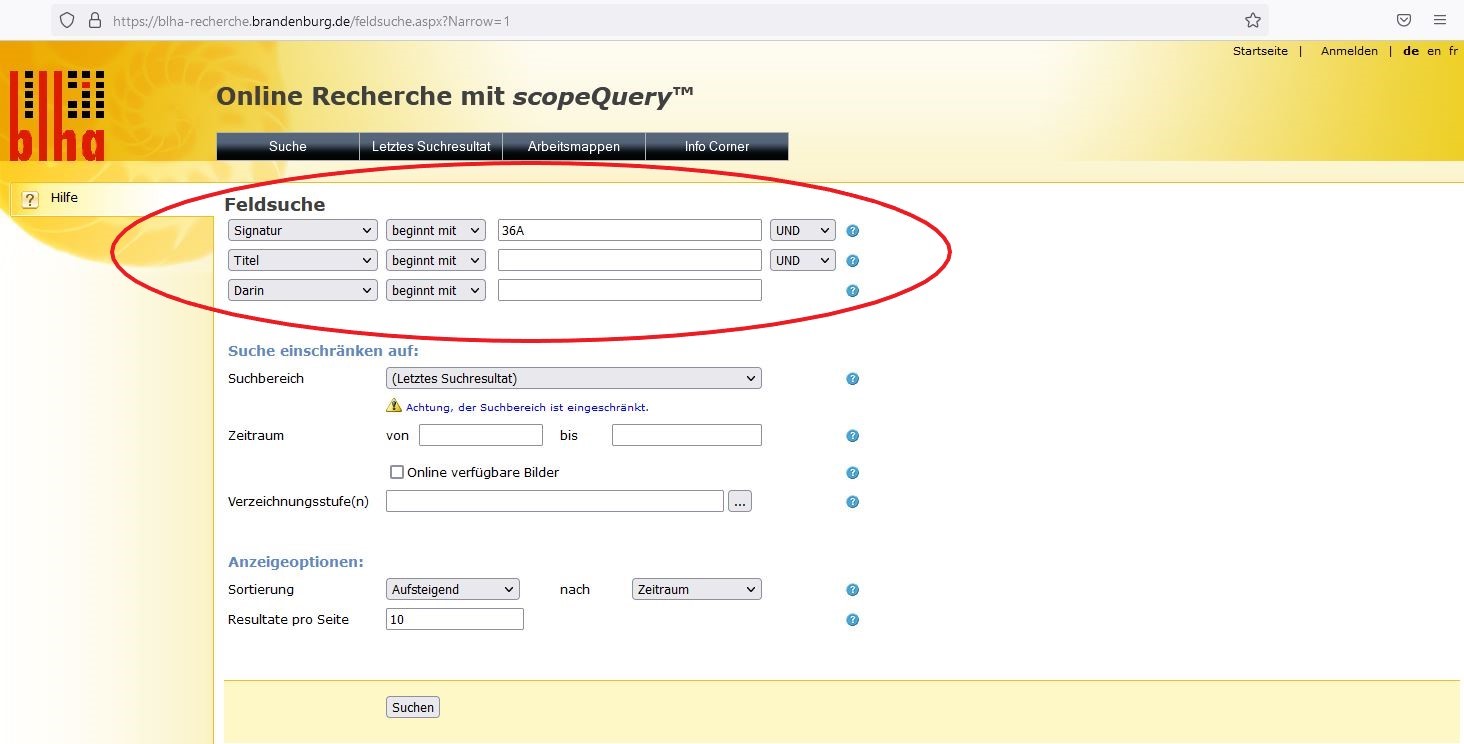
ALT TEXT: Formular der Feldsuche
Searching within the results list is only possible using predefined fields. Searchable fields are Title, Signature, Contains note (In) and Description. You can use the signature to display search results from a specific fonds. To search the Asset Realisation Office’s holdings, use 36A.
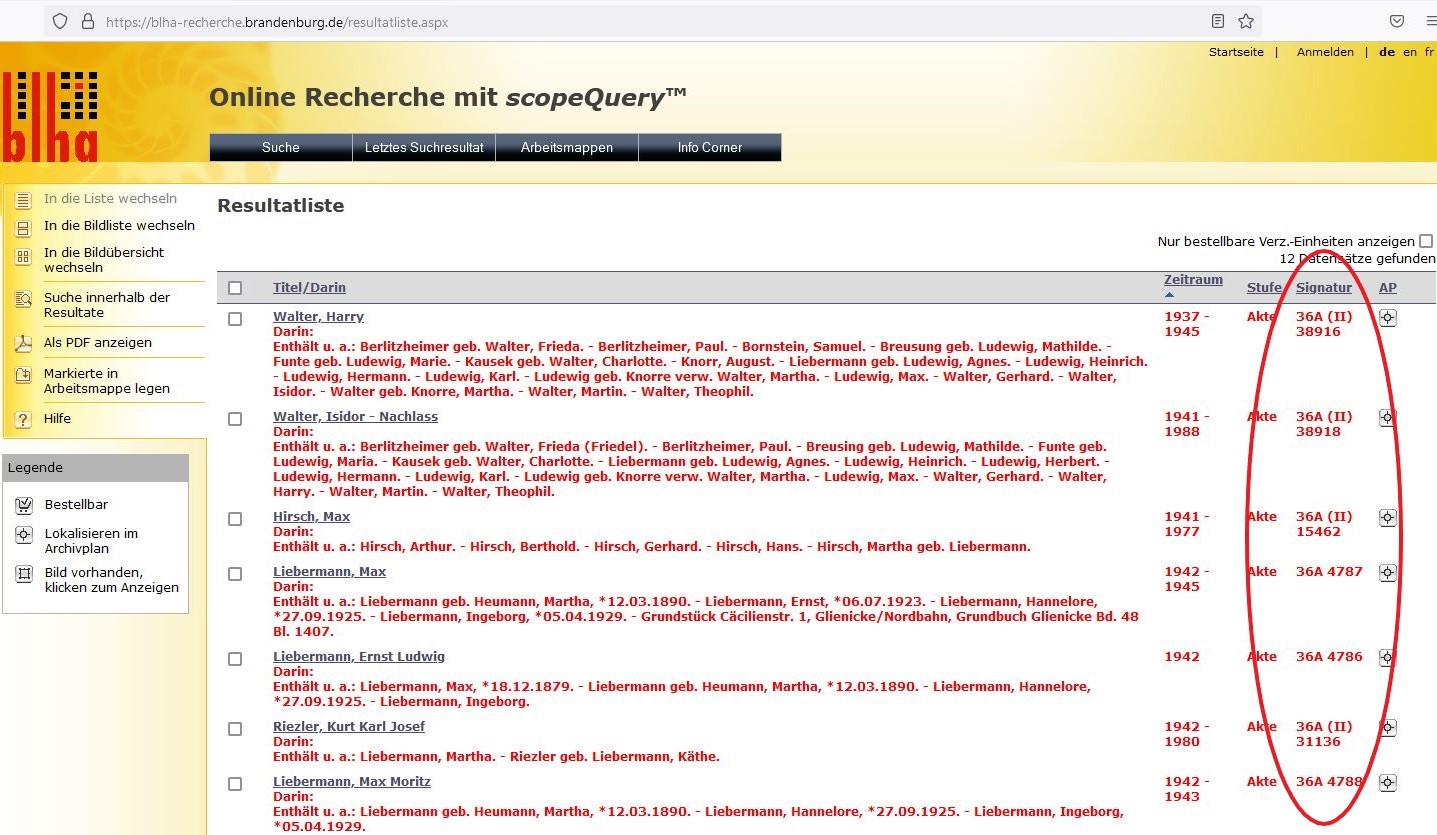
ALT TEXT: Adjusted hit list with signatures from Rep. 36 A II
Only hits from the database of the Chief Finance President Berlin-Brandenburg are displayed.
Full text search OFP file number
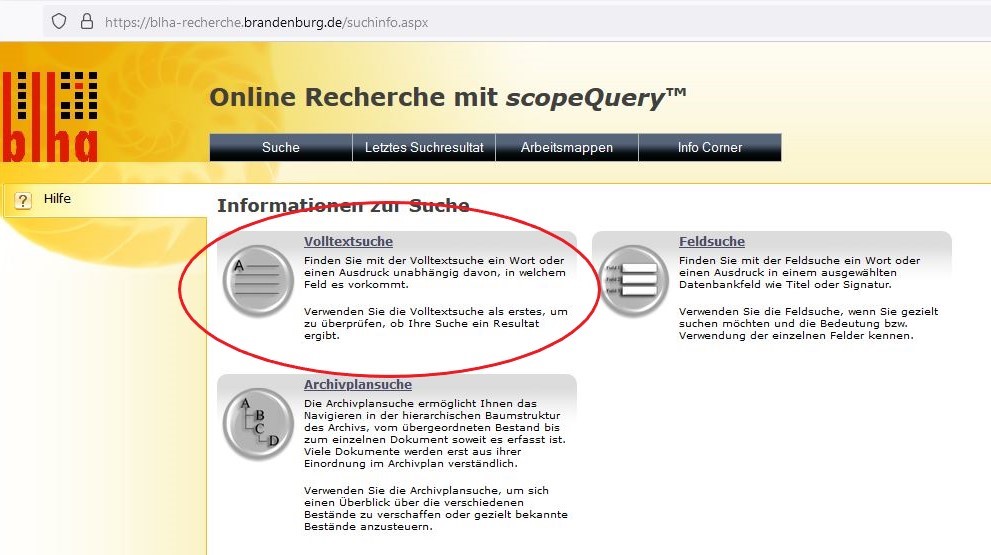
ALT TEXT: Scope Query start page with the three search functions full text search, archive plan search and field search
1. Open the online search of the Brandenburg State Archives at https://blha-recherche.brandenburg.de/suchinfo.aspx and select the full text search.
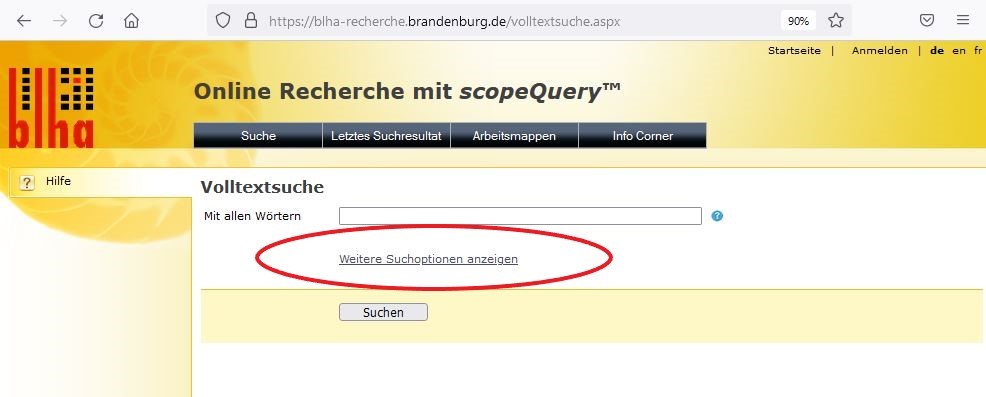
ALT TEXT: Search field with highlighted link to ‘Show more search results´.
Now select the ‘Show more search options’ option.
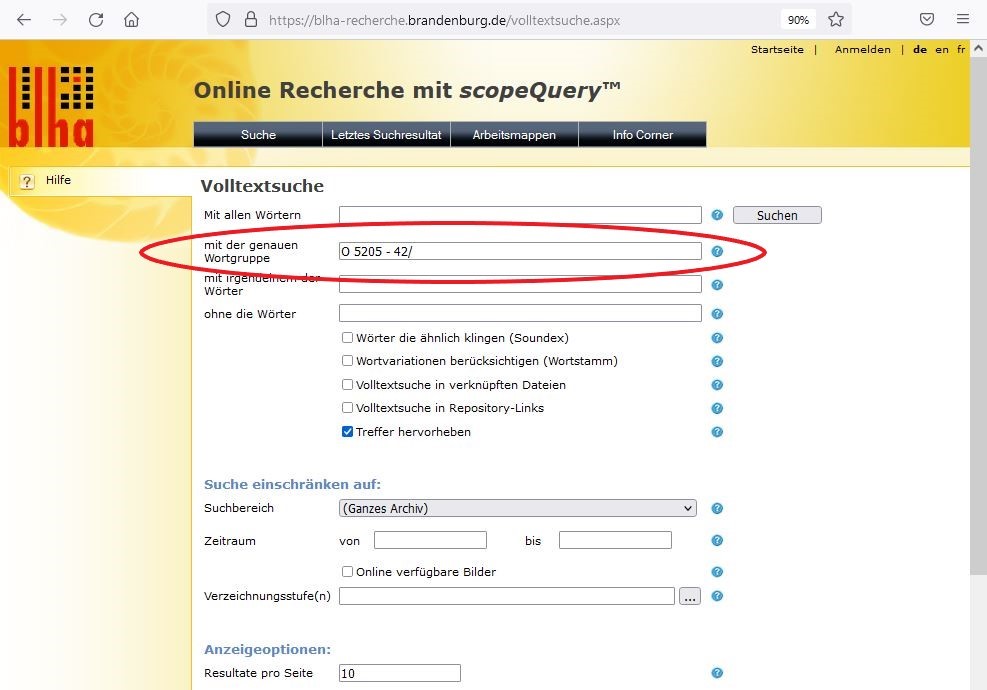
ALT TEXT: Highlighting the ‘with the exact phrase’ function in the full-text search form with additional search options folded out.
If you are looking for a specific deportation wave, use the search function ‘with the exact word group’ and enter the standardised OFP file number. In this example, we are looking for database entries on deportation wave 42. You can obtain a detailed list of the transport waves from Berlin from the Arolsen Archives at: https://collections.arolsen-archives.org/en/archive/1-2-1-1_VCC-155-I.
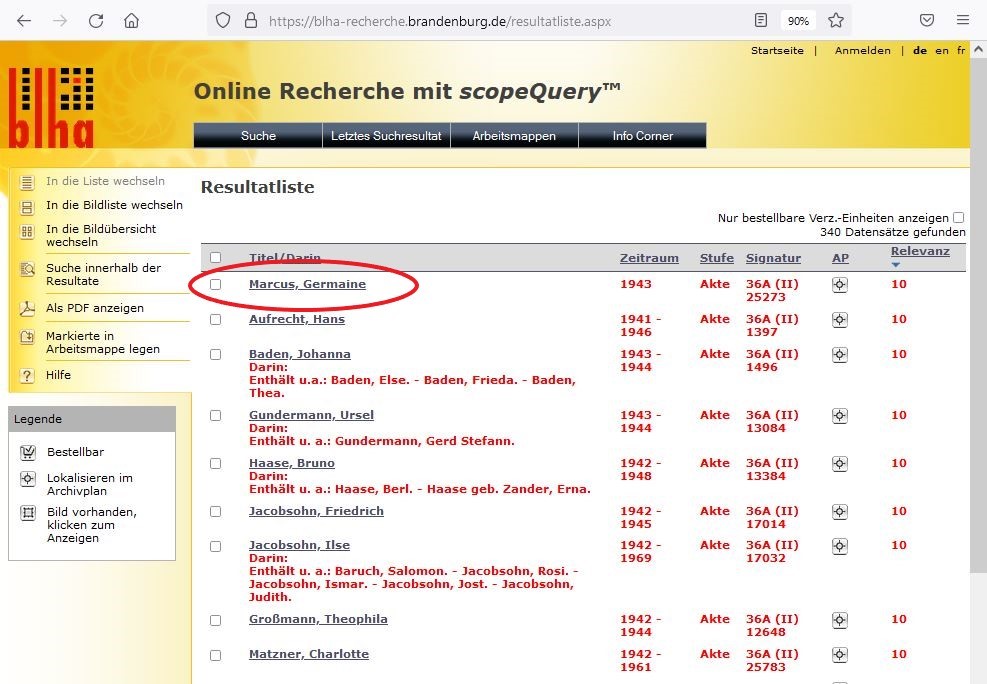
ALT TEXT: List of results with the name Marcus, Germaine emphasised.
You will receive a hit list of persons who were deported with the 42nd wave. To view the records in detail, click on the title of the respective directory unit.
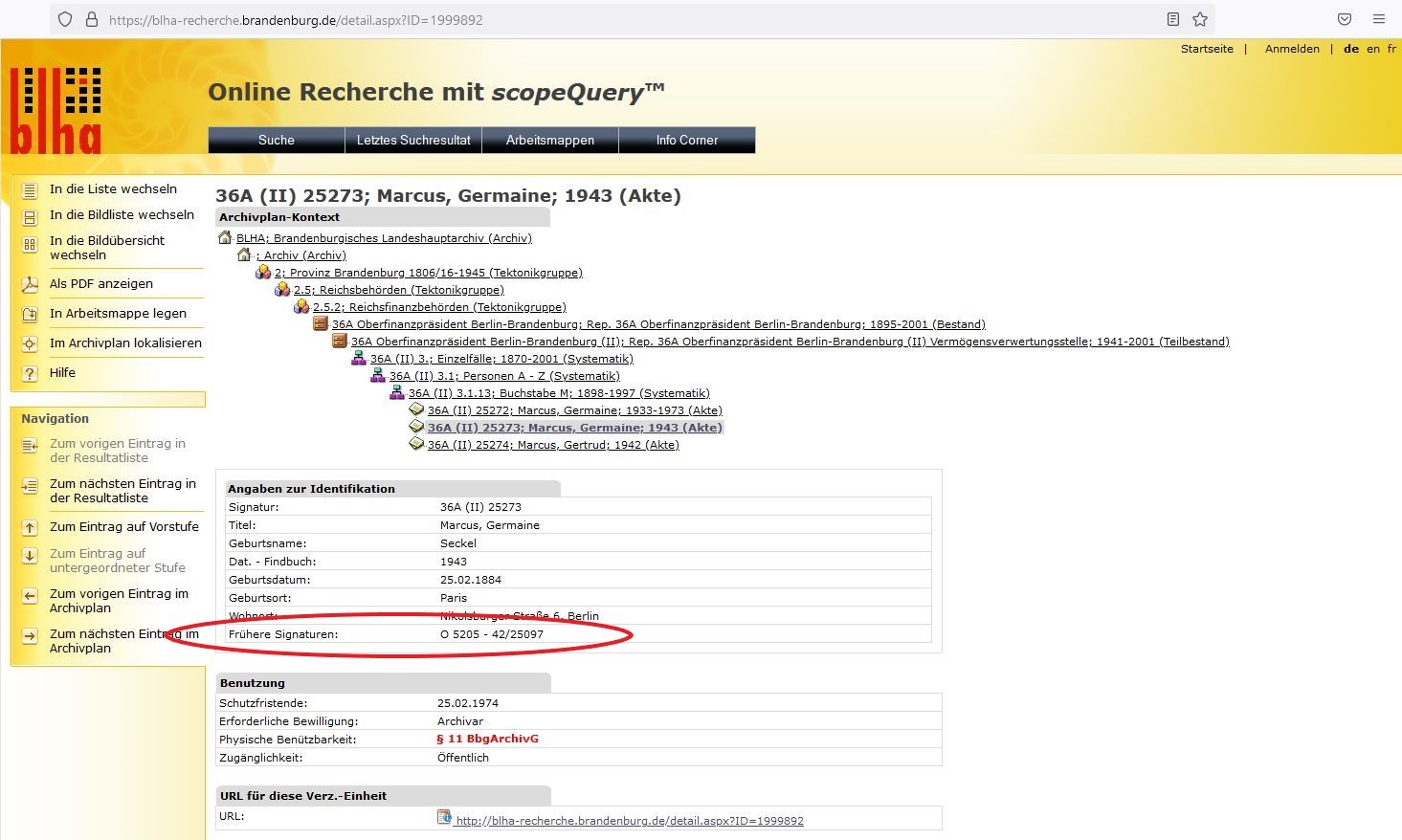
ALT TEXT: Data record with highlighted field ‘Previous signatures’.
In the Previous signatures field, you can check whether the search result matches the hits you are looking for.
Full text company search
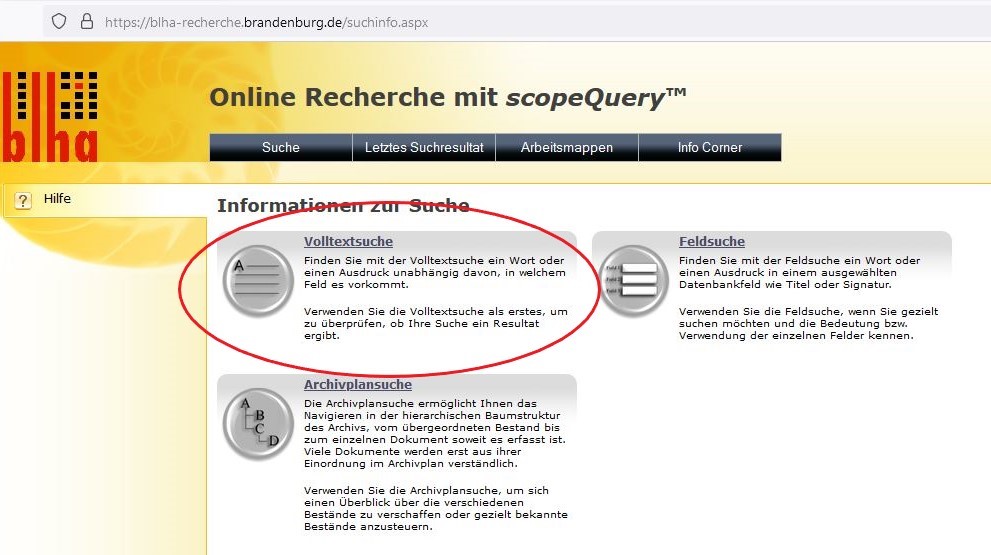
ALT TEXT: Scope Query start page with the three search functions full text search, archive plan search and field search, the full text search is highlighted
1. Open the online search of the Brandenburg State Archives at https://blha-recherche.brandenburg.de/suchinfo.aspx and select the full text search.

Enter the string “Fa.” into the search slot.
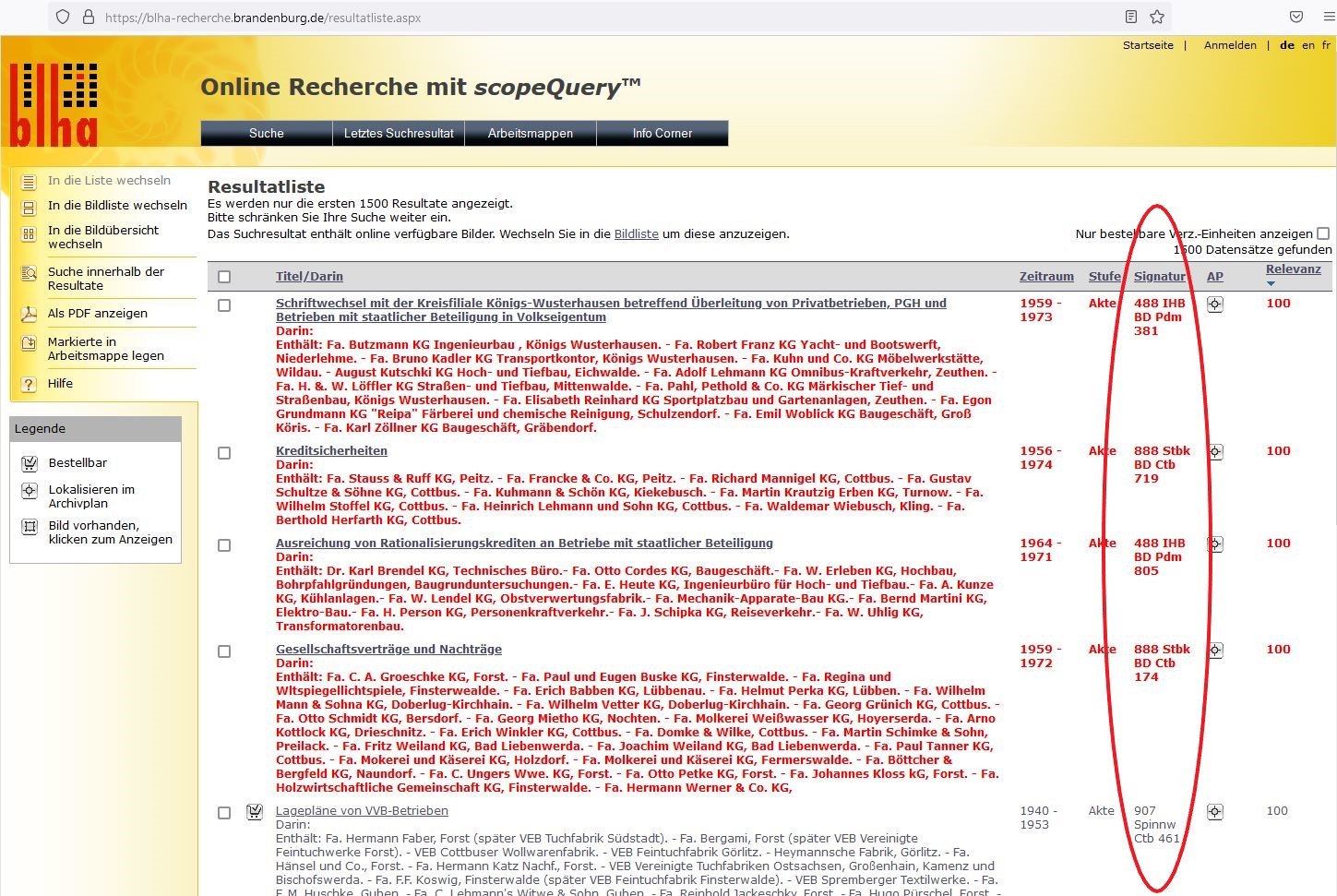
ALT TEXT: Result list with highlighted signature column with signatures from different stocks
In the hit list, you will see all entries in the database that use this abbreviation. This also includes entries that do not relate to the portfolio of the Asset Realisation Office.
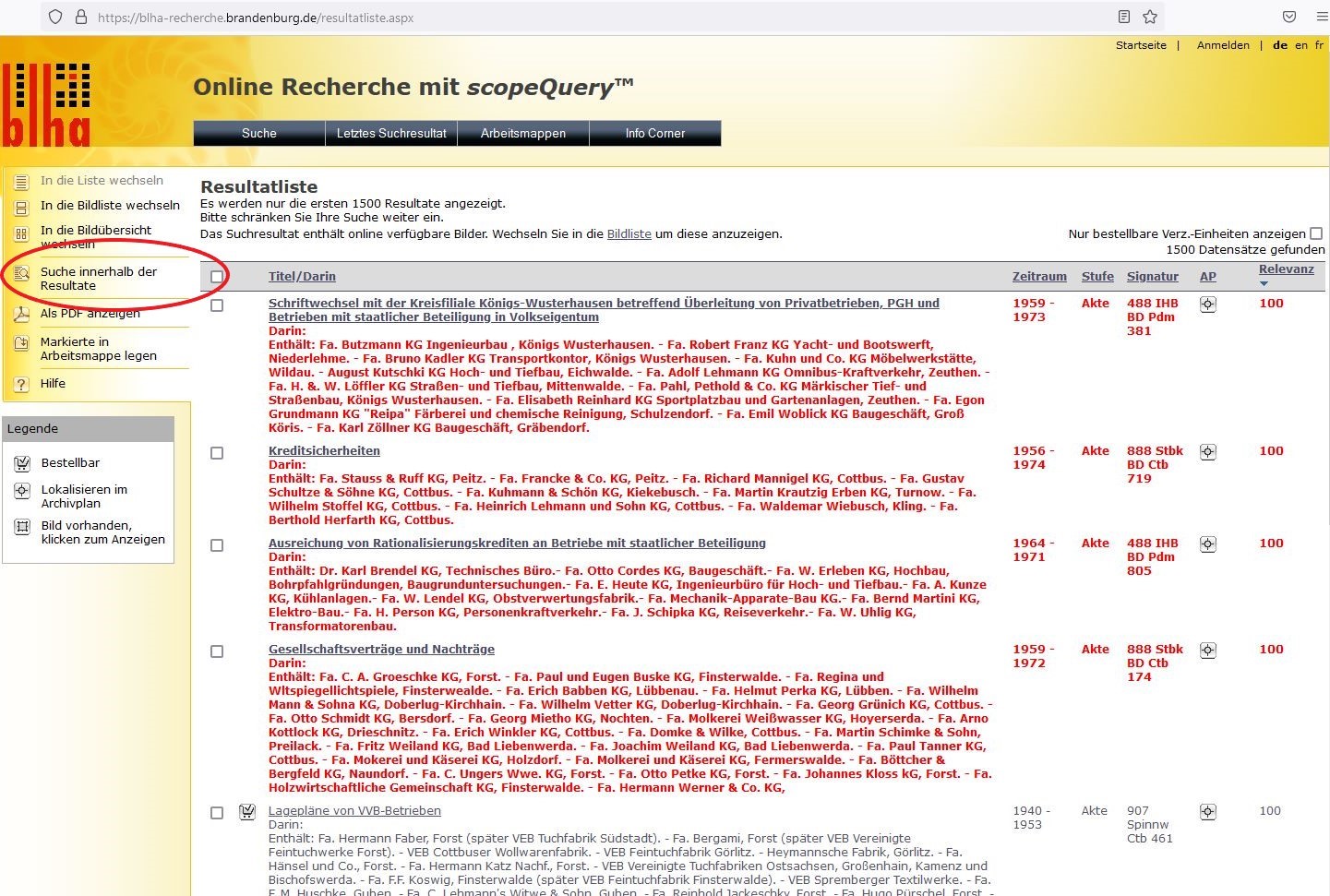
ALT TEXT: Highlighting the ‘Search within the results list’ function in the margin column on the left
You can then initiate a ‘Search within the results list’ via the navigation.
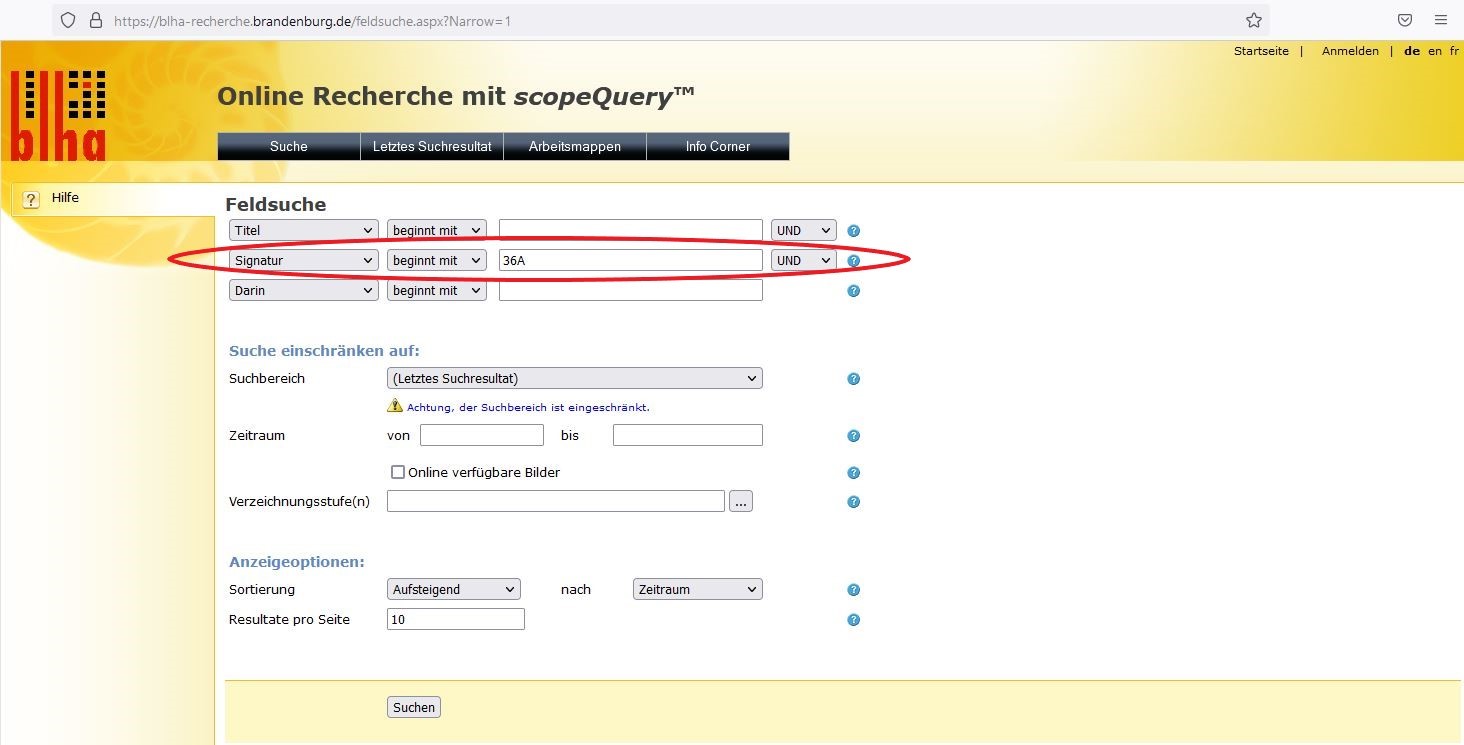
ALT TEXT: Highlighting of the ‘Signtaur’ function in the field search form, other fields are ‘Title’ and ‘In’
Then search in the field search via the Signature field for the fonds signature beginning with ‘36A’ to obtain all entries relating to the Chief Finance President Berlin-Brandenburg.
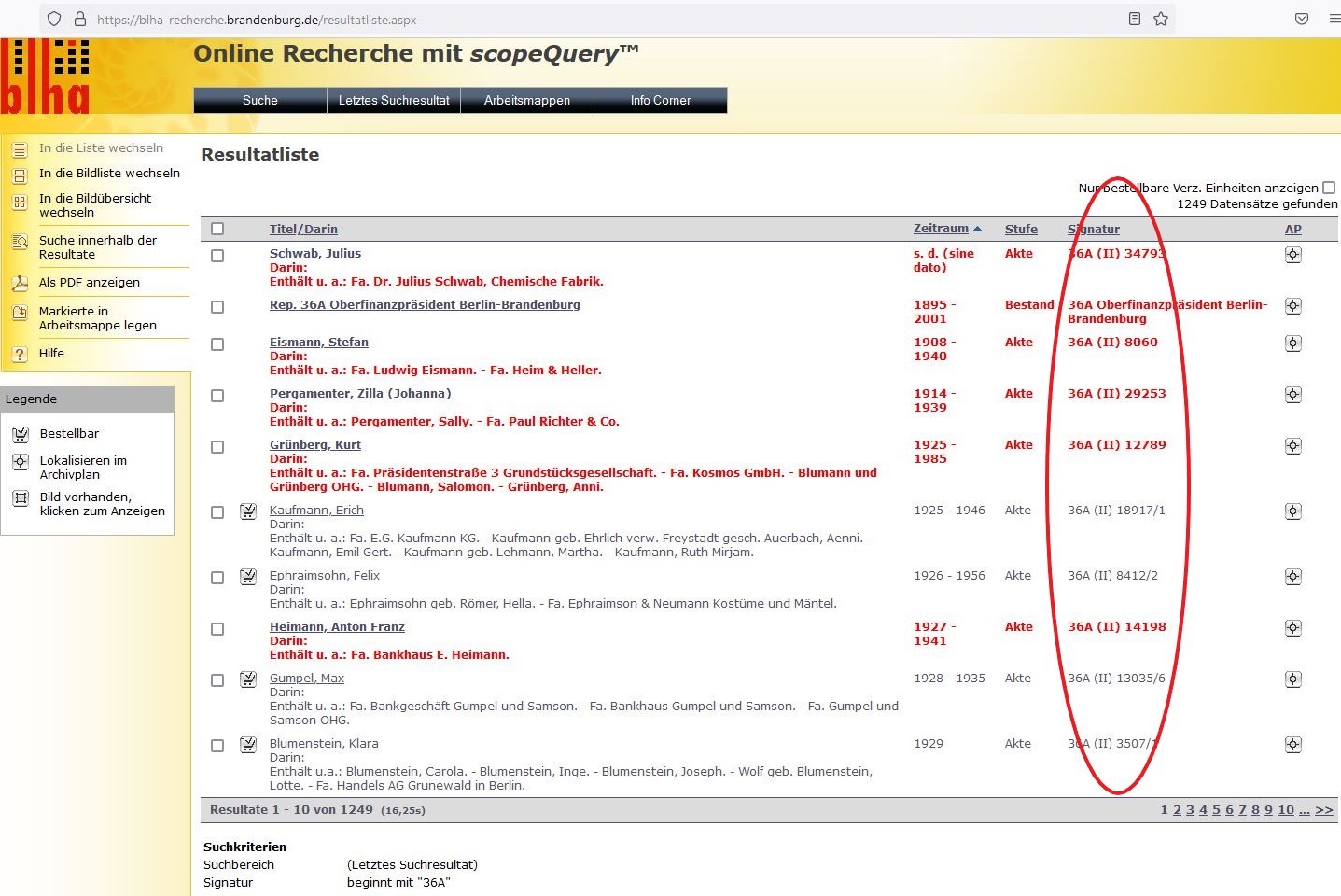
ALT TEXT: Results list with highlighted signature column with signatures only from Rep. 36 A II
In the hit list you will now only see hits from the holdings of the Chief Finance President Berlin-Brandenburg.
Soundex search
This search is particularly useful for name searches where several spellings of a name may occur and it is not certain whether the name you are looking for is recorded in the database. This applies in particular to first names with several possible spellings such as Martha or Marta or surnames such as Feilchenfeld or Feilchenfeldt. This search usually returns many hits in the first search run, which should then be narrowed down further. A soundex function is only possible in the full text search, but not in the field search.
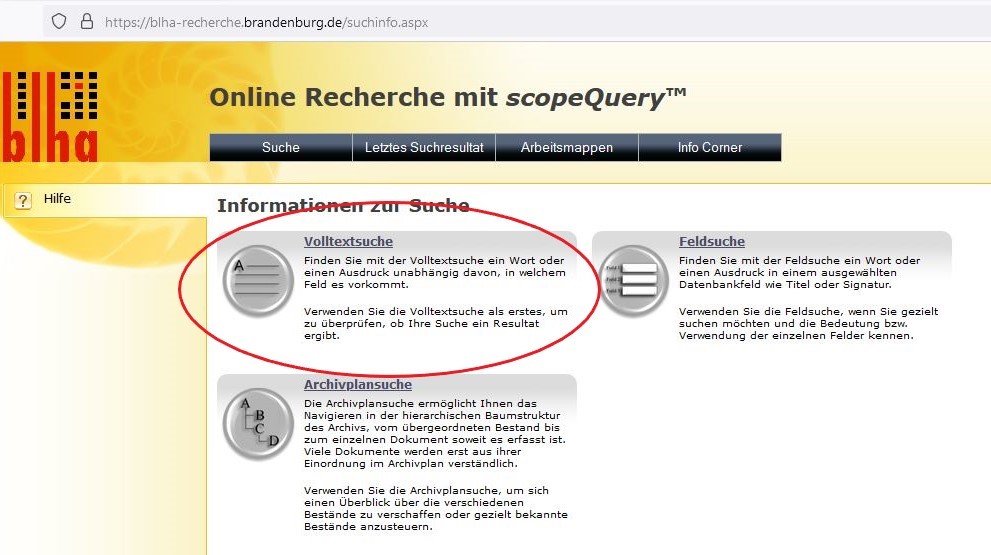
ALT TEXT: Startseite von Scope Query mit den drei Suchfunktionen Volltextsuche, Archivplansuche und Feldsuche, die Volltextsuche ist hervorgehoben
1. Open the online search of the Brandenburg State Archives at https://blha-recherche.brandenburg.de/suchinfo.aspx and select the full text search.
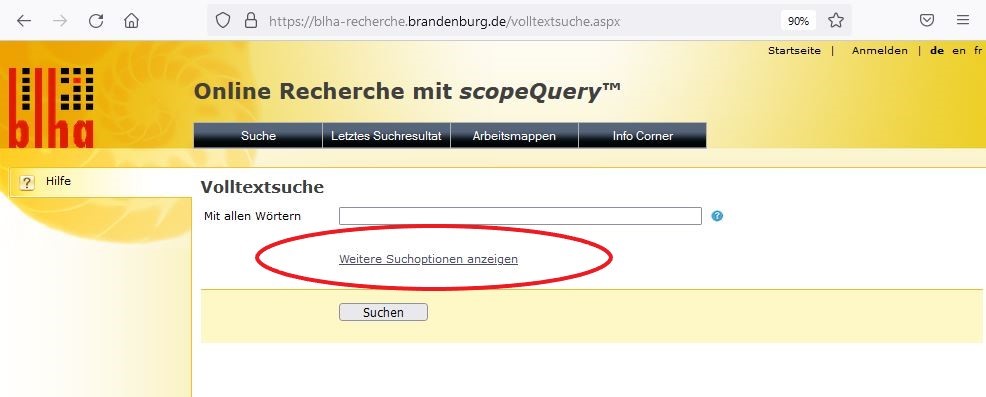
ALT TEXT: Full-text search field with highlighted link to ‘Show more search results’
Now select the ‘Show more search options’ option.
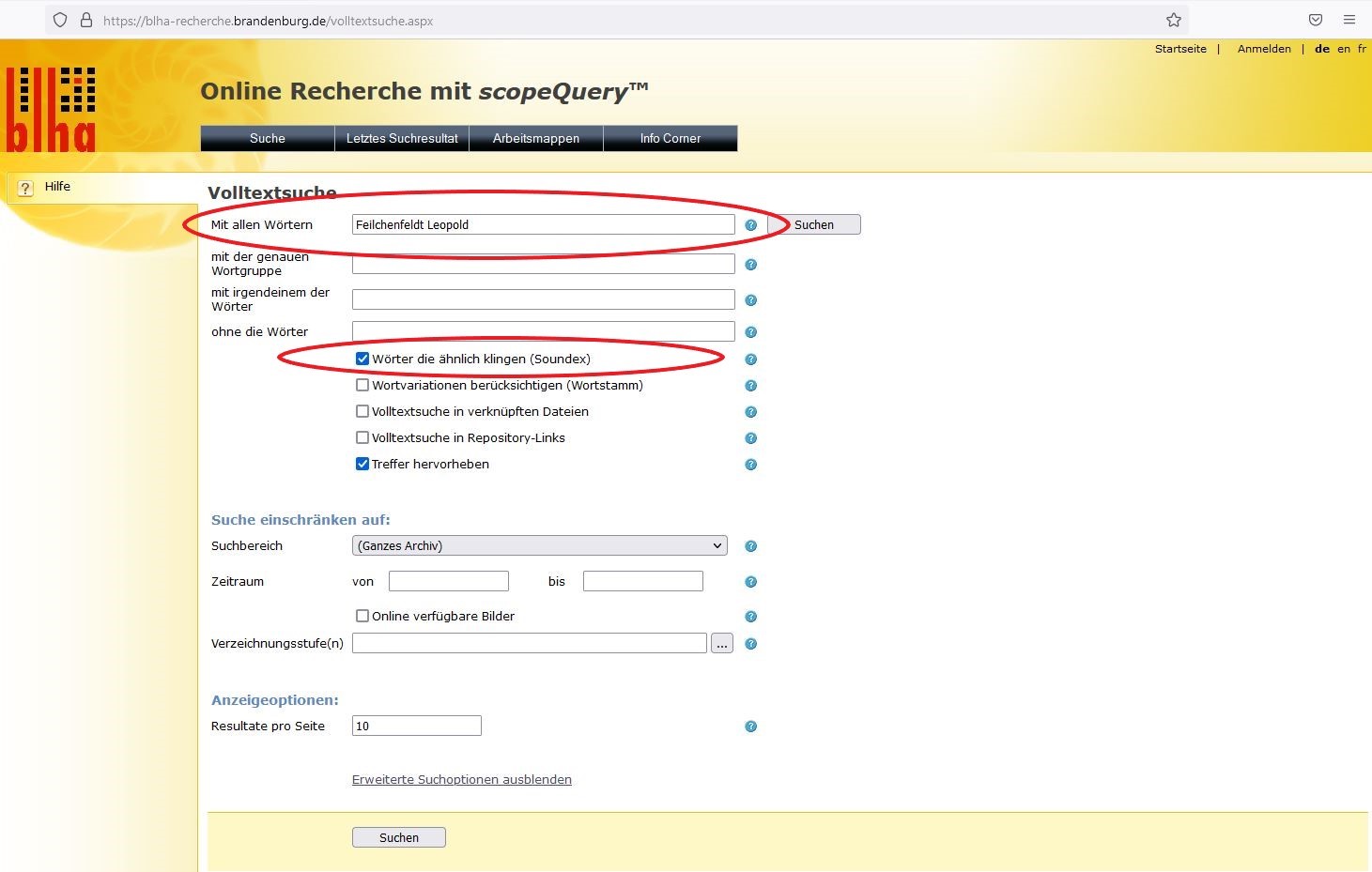
ALT TEXT: Full text search form with highlighted fields ‘With all words’, here entered name Leopold Feilchenfeldt and selected field ‘Words that sound similar (Soundex)’
In the detailed search, select ‘Words that sound similar (Soundex)’ and enter the search term in the desired field. Here we are looking for the medical officer ‘Leopold Feilchenfeldt’, born on 24 June 1861 in Culm.
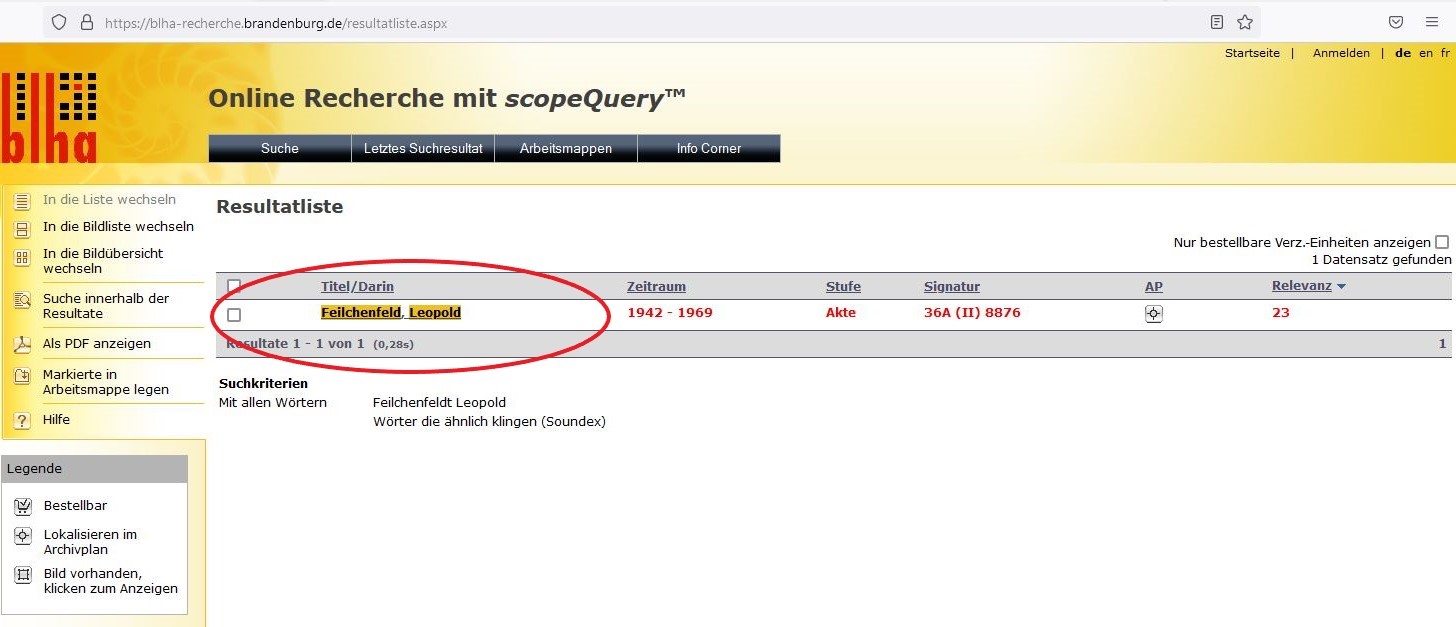
ALT TEXT: Results list with one hit, emphasising the name Feilchenfeldt, Leopold
The database contains only one entry for Feilchenfeld Leopold.
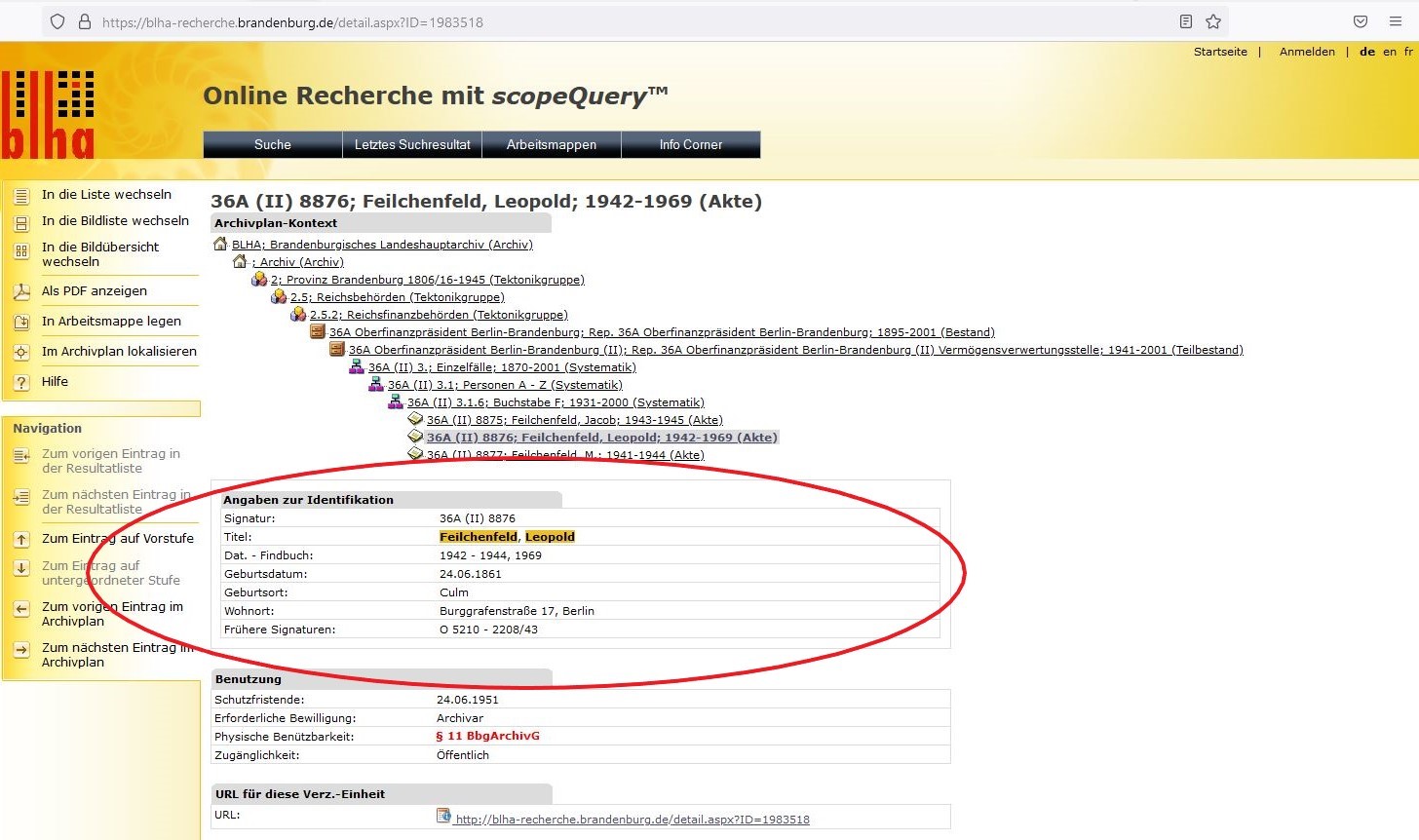
ALT TEXT: Data record for Leopold Feilchenfeldt with the information SIgnature, birth name, date of birth, place of birth, address, protection periods and a permalink to the data record
If you open the data record in the hit list, you will see that all the data entered in this data record matches the vital data of the medical officer you are looking for. The discrepancy in the spelling of the name is due to the fact that Leopold Feilchenfeldt is listed exclusively as Leopold Feilchenfeld in the file. In addition, it is always possible that typing errors occurred during the indexing process.
Field search
Searching in the field search is only possible via predefined fields. Searchable fields are Title, Signature, Contains note (In) and Description. There are the options ‘begins with’, ‘contains’, ‘ends with’ or ‘is equal to’ to search in the respective field. A soundex function is not available here. This type of search is particularly suitable if you are already searching for known directory units. This search function is only suitable to a limited extent for an introductory search.
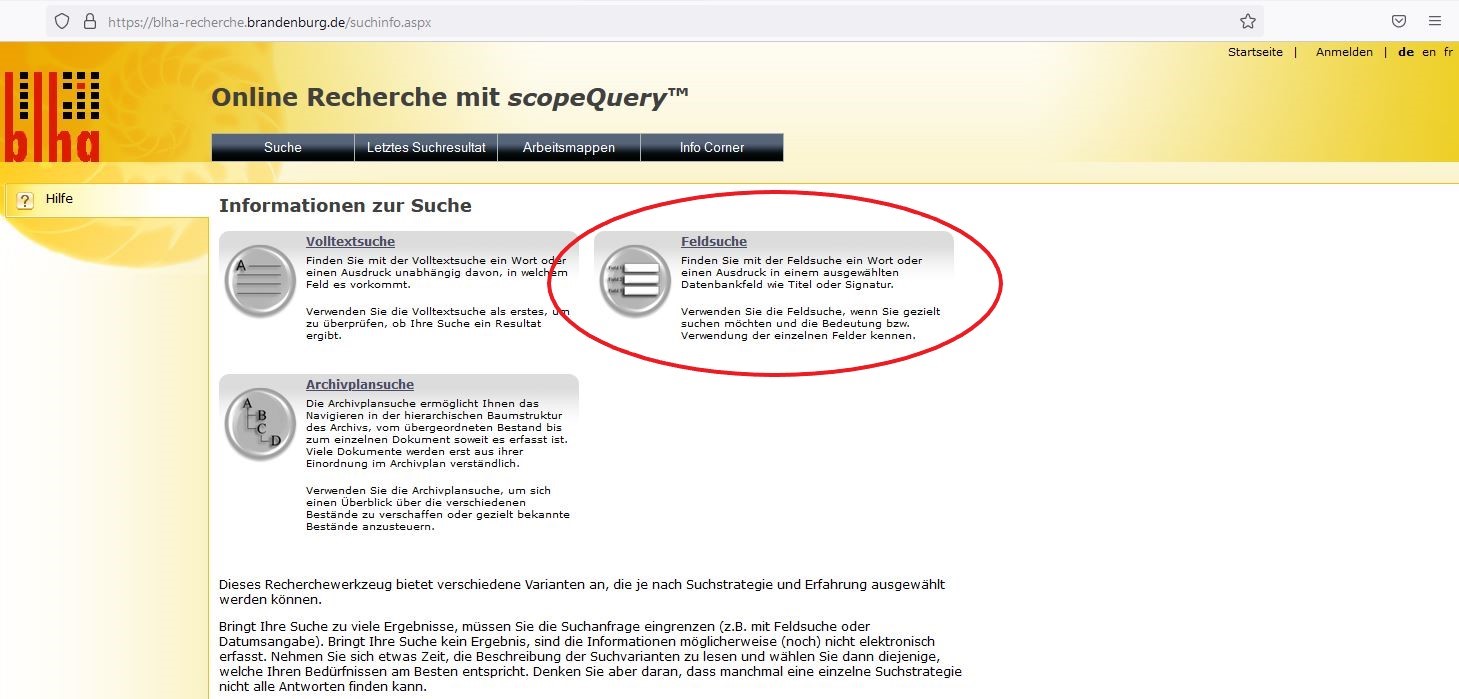
ALT TEXT: Scope Query start page with highlighted field search
1. Open the online search of the Brandenburg State Archives at https://blha-recherche.brandenburg.de/suchinfo.aspx and select the field search.
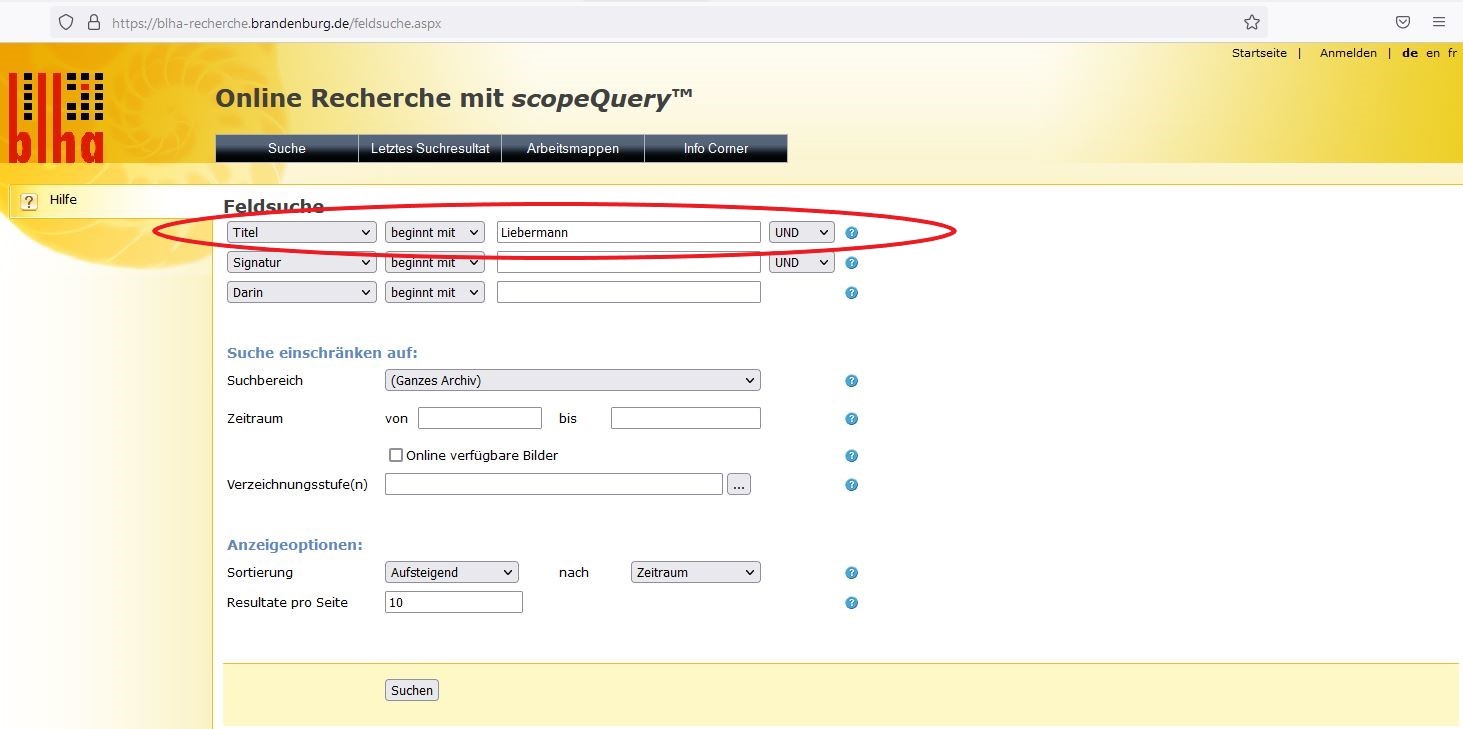
ALT TEXT: Field search: Title field highlighted, the name Liebermann is entered
Using the search in the title field with the search option ‘begins with’, you can search for all database entries whose title begins with ‘Liebermann’ in this example.
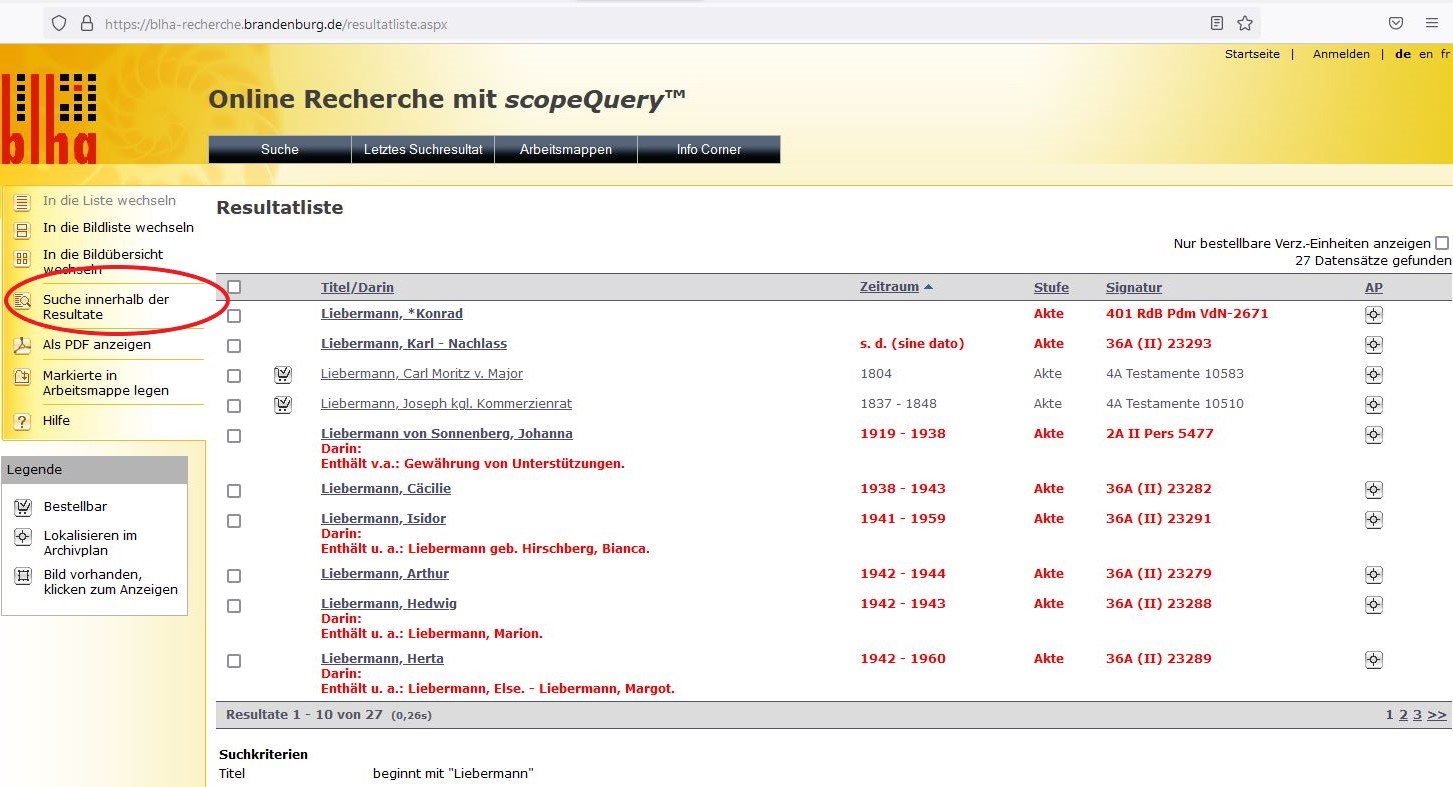
ALT TEXT: Results list with hits for the name Liebermann, highlighted in the marginal column on the left is the function ‘Search within the results list’
You can then initiate a ‘Search within the results list’ via the navigation.
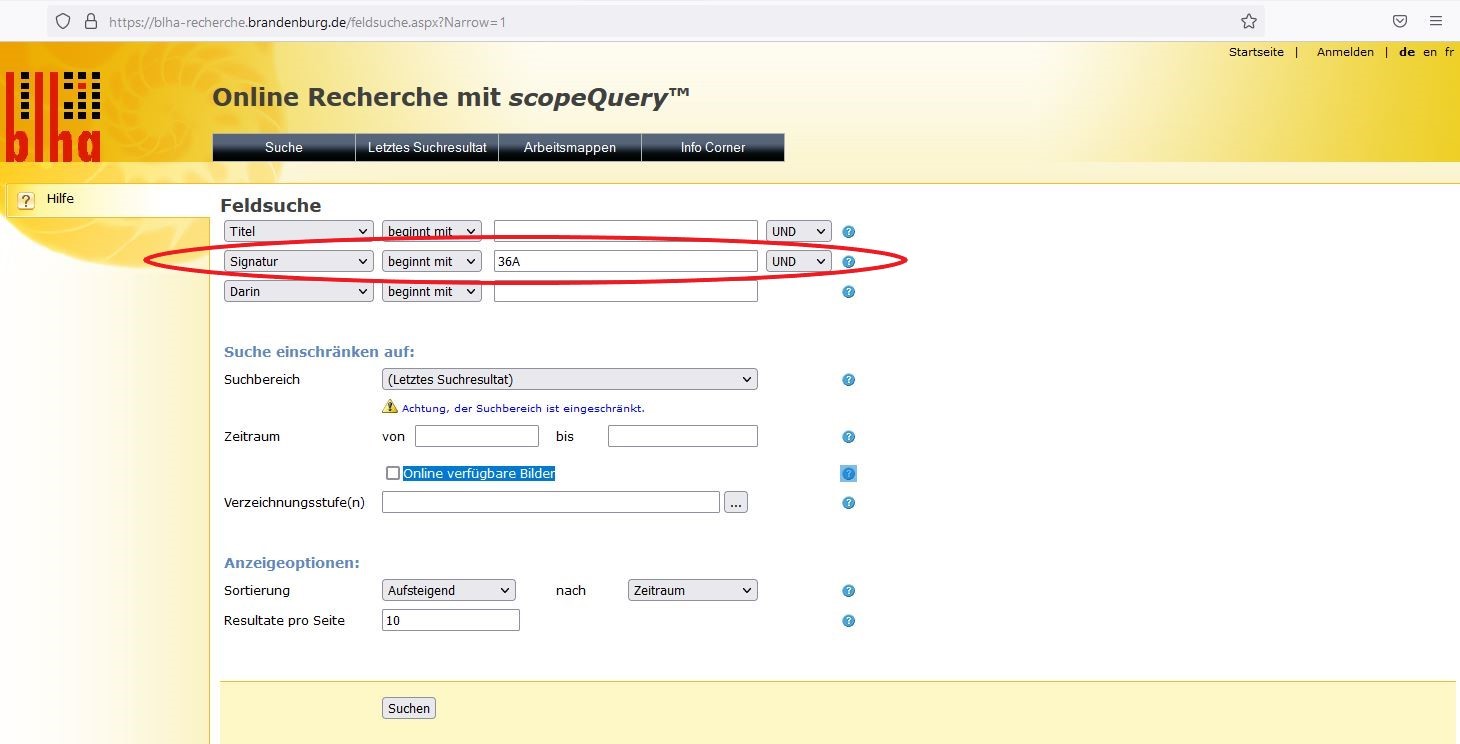
ALT TEXT: Field search: Signature field highlighted, the repository ‘36A’ is entered
For example, to obtain only hits relating to the holdings of the Chief Finance President, search for ‘36A’ in the ‘Signature’ field.
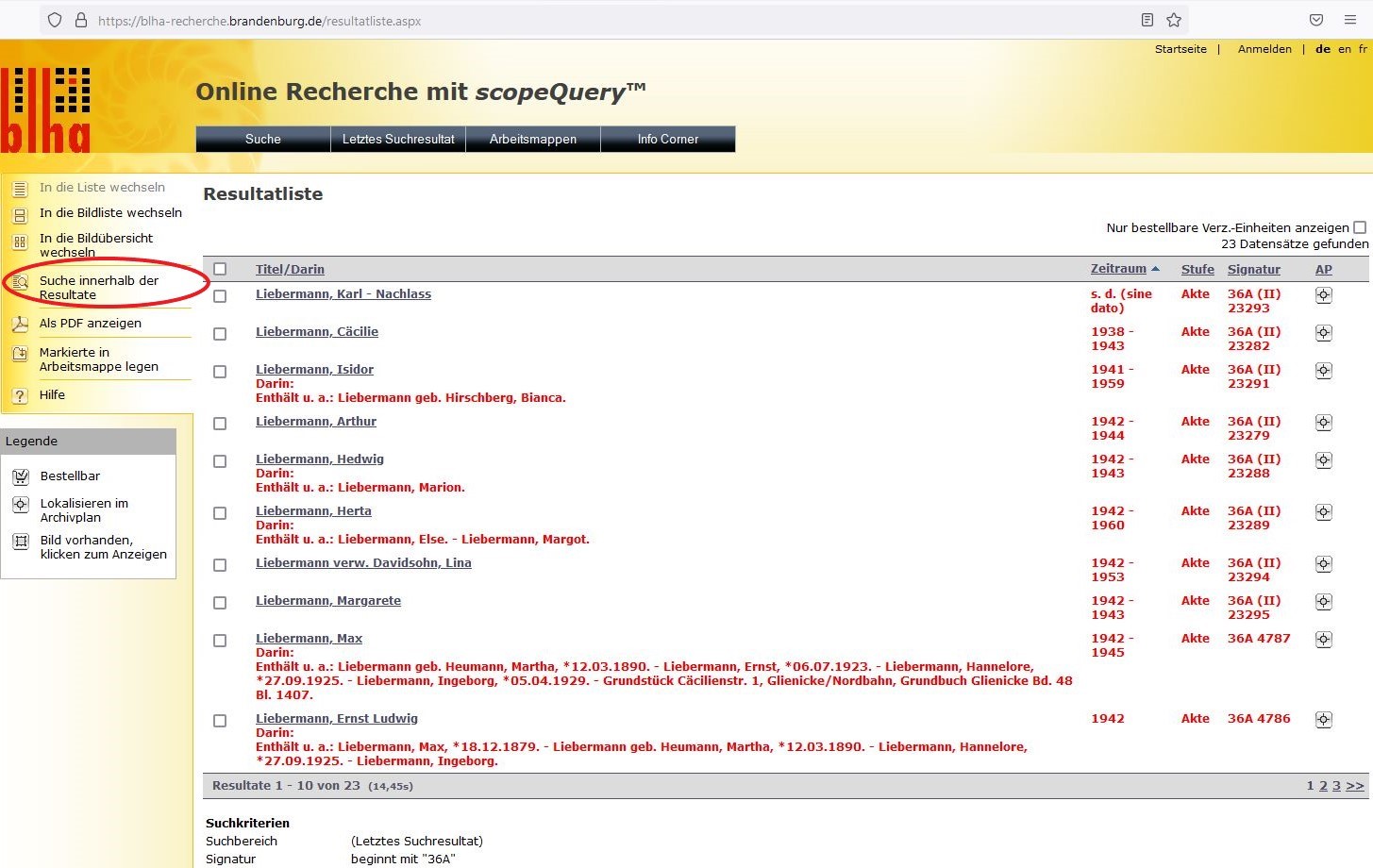
ALT TEXT: Highlighting the ‘Search within the results list’ function in the margin column on the left.
The search can then be refined as often as required.
Development and handling of compulsory names
During the cataloguing of the collection, the compulsory names were not recorded due to their discriminatory character. When using the fonds for publications and projects, the forced names should not be used in order to prevent the reproduction of perpetrator terminology.

ALT TEXT: Fanny Harik record contains surname, maiden name, date of birth, place of birth, address, companies, terms of protection and a permalink to the record.
Figure 1: Example data set with all data fields released for use.
Explanation of the individual data fields
Title
The title is usually formed by the name of the main person in the file. The names that form the title of the file are made up of ‘surname, first name’.
Widowed, remarried women for whom a ‘widowed + surname marriage 1’ was added after the surname are a special case. The maiden names of married women listed in the title were recorded in the ‘maiden name’ field.
A further exception is estate files that were kept for communities of heirs. Here, the name of the deceased and a ‘- estate’ added after a hyphen form the title. The persons affected by the probate matter are recorded in the ‘Contains note’.
In the case of several spellings of a name, e.g. Elisabeth, Elisabet, the spelling that occurs most frequently in the file has been recorded as the main name. All others are listed in round brackets ‘()’ after the main name, e.g. Elisabeth (Elisabet). Nicknames or nicknames are also recorded in the round brackets.
Date-findbook
The duration indicates the year of the oldest and most recent document in the file. The year separated by a comma refers to the most recent document of the documents added to the file after 1945. The years from 1945 onwards provide an indication of any documents relating to compensation or restitution proceedings.
Date of birth
The date of birth is recorded in the format dd.mm.yyyy
Place of birth
The places of birth were adopted according to the spelling in the records. Special characters from Polish, Hungarian, Czech etc. were not taken into account, e.g. Długa = Dluga; Przemyśl = Przemysl.
When researching, please bear in mind that places changed names within a short period of time. It is therefore possible that one person gave their place of birth as Hindenburg and another as Zabrze. Both place names refer to the same town. The decisive factor here is whether the person in question was born before or after 1915. All place names should therefore always be included in the research.
In the case of place names that exist more than once, the place suffix was recorded – if indicated in the file. River names were added in round brackets, e.g. Frankfurt (Main) or Frankfurt (Oder). Landscape names or regional names after a ‘/’ e.g. Katy/Galicia or Strasburg/West Prussia.
Place of residence
The Place of residence field lists all the places of residence that could be determined for a person based on a comparison of existing addresses in the indexing data and the residential addresses recorded in the Berliner-Gedenkbuchdatenbak. These may include the places of residence of the person listed in the title over several years or decades.
The street spelling is based on the generally accepted street names at the time the file was created. An overview of the different spellings and changes in naming can be found in the directory of historical street names in Berlin: https://berlingeschichte.de/berlinaz/indexabz.htm or in Kaupert’s street guide through Berlin: https://berlin.kauperts.de/.
The generally accepted abbreviation for streets, ‘Str.’, has been removed from all of the sub-collections of the Asset Realisation Office.
Addresses comprising several house numbers were standardised in such a way that the most commonly used spelling from the files was transferred to the same address. Occurring spellings are those with a hyphen ‘/’ and a hyphen ‘-’, e.g. Brunnenstraße 10/12 or Braunauer Straße 216-218.
As it is quite possible that persons for whom files were kept in the Asset Realisation Office of the OFP Berlin-Brandenburg also had previous residences outside Berlin, the corresponding place name was recorded after the address, e.g. Braunauer Straße 216-218, Berlin or Grüne Wiese 23, Guben.
Volume numbers
For multi-volume files: Number of the file volume in Roman numerals.
Former shelfmarks
The file numbers assigned in the Asset Realisation Office are recorded in the fonds Rep. 36A (II) under ‘Former shelfmarks’. They provide a rough indication of whether the person for whom the file was created was able to leave Germany or was deported to a concentration or extermination camp in the course of the deportations.
O 5205 –
According to the 1938 file plan of the Reich Ministry of Finance (RMF) for assets ‘confiscated in favour of the Reich.’ From 1941 de facto for deported persons. The file numbers of file group O 5205 generally follow a fixed scheme.
The file number O 5205 – is followed by the number of the deportation wave (caution: not the transport number). This was done in Roman numerals up to deportation wave 30 (e.g. XV for the age transports 4-8 to Theresienstadt in the period from 9 June 1942 to 19 June 1942). From wave 31 onwards, the numbering was continued in Arabic numerals. This is followed by a ‘/’ and a consecutive number in Arabic numerals assigned by the registry in the Asset Realisation Office.
Here are two examples: O 5205 – XXV/13195 refers to the 25th transport wave and therefore to the 18th eastern transport to Riga and the 44th old-age transport to Theresienstadt. O 5205 – 48/30498 refers to the 48th transport wave and therefore to the 34th eastern transport to the Auschwitz concentration and extermination camp.
If you are looking for files relating to a specific deportation wave, use the following search query ‘O 5205 – wave number’. Caution: There are minor exceptions to this rule, but they do not follow any identifiable scheme. You can access the digital copies of the transport lists via the online archive of the Arolsen Archives at https://collections.arolsen-archives.org/en/archive/1-2-1-1_VCC-155-I. The names can also be researched there.
Special file number O 5205
In addition to the standard file number, there are other file numbers with a special meaning:
O 5205a – +consecutive number
Special file number for so-called ‘enemies of the Reich’. The files kept under this file number relate to a very heterogeneous group of people to whom the 11th Ordinance could not be applied. This includes, for example, political opponents of the Nazi regime, Eastern European forced labourers or stateless persons. In the case of secret files, a small ‘g’ is added after the consecutive number.
An example: O 5205a – 15
The BLHA has its own finding aid for all Reich enemy files under Rep 36A Oberfinanzpräsident Berlin-Brandenburg (II) No. 55204.
O 5205 – ‘T-’ + consecutive number
This concerns persons who died after the enactment of the 13th preliminary regulation to the Reich Citizenship Act. This regulation considerably simplified access to estates.
An example: O 5205 – T-315
The Landeshauptarchiv has a separate finding aid for this with the shelfmark Rep. 36A Oberfinanzpräsident Berlin-Brandenburg (II) No. 55265.
O 5205 – Sm-+Wellennummer/+Fortlaufende Nummer
This file number refers to persons who escaped deportation by fleeing or committing suicide. There are several spellings of the file number on and in the files, e.g. Sm-+Wellennummer/+Fortlaufende Nummer; Sm+Wellennummer/+Fortlaufende Nummer; Sm-+Wellennummer/+Fortlaufende Nummer. To standardise the information, the file number has been adopted as above.
An example: O 5205 – Sm-60/36609
The lists of the Gestapo in which the Asset Realisation Office was informed which persons evaded deportation by going into hiding or committing suicide are incompletely preserved in the State Main Archives under Rep. 36A Oberfinanzpräsident Berlin-Brandenburg (II) No. 56000-56004.
O 5025 – Erm+consecutive number
This is a file in which the documents received first had to be assigned to a case by the registry. This was carried out by the Investigation Department, which provisionally assigned this file number. Cases that could not be assigned to a file number retained the provisional file number.
An example: O 5205 – Erm-6972
O 5205 – Zg-+consecutive number
This file number is a temporary file number and identifies processes that were first recorded in the registry. A regular file number was usually assigned later. File numbers created in this way are the exception.
O 5210 –
According to the 1938 file plan of the Reich Ministry of Finance (RMF) for assets ‘declared forfeited in favour of the Reich.’ From 1941 de facto for emigrants and estates/communities of heirs. This is followed by a consecutive number and the year of asset forfeiture separated by ‘/’. The consecutive number starts again at 1 for each year.
An example O 5210 – 11092/43
File number of the Moabit-West tax office S 1110 and O 1300
In addition to the file numbers assigned by the Asset Realisation Office at the OFP Berlin-Brandenburg, there are still remnants of file numbers assigned by the Moabit-West tax office. The file numbers S 1110 and O 1300 are precursor file numbers of O 5210 and are structured in the same way. In April 1941, the majority of the two file numbers were exchanged. Only a small number of expatriation procedures have retained this file number.
Contains note
Names
Names were recorded according to the spelling of the names in the files. In the ‘contains’ note, the name of male persons is formed as in the title. For married females, ‘surname born maiden name, first name’. If you are looking for female persons, search both with and without maiden name. If a woman is also widowed, the maiden name is given first and then the widowed name, e.g. Friedländer, née Grün, widowed Schmid, Margarete.
Companies
Companies, corporations, joint-stock companies, banks and commercial enterprises are indicated in the ‘contains’ note with a ‘Fa.’ in front. The spelling of the above is taken from the files. Deviations from the names entered in the commercial register etc. are therefore possible. Companies without a city suffix were generally located in Berlin.
Names and companies are separated by the character string ‘. -’ from each other.
Reference
All other addresses associated with the file are recorded here. This includes the property of the person from the main file, business addresses, but also addresses of other persons named in the file or the ‘contains’ note.
Research examples
Full text search personal names

ALT TEXT: Scope Query start page with the three search functions full text search, archive plan search and field search, the full text search is highlighted:
1. Open the online search of the Brandenburg State Archives at https://blha-recherche.brandenburg.de/suchinfo.aspx and select the full text search.

ALT TEXT: Full text search with example search for Martha Liebermann in highlighted search field
Enter the name of the person you are looking for in the search slot. The form of the entry is not relevant for this search.

ALT TEXT: Hit list with the name Martha Liebermann, in the list the title, beginning of the contains note, duration and signature are visible
All entries containing ‘Liebermann’ and ‘Martha’ in any field will be found. To view a record in more detail, simply click on the title.

ALT TEXT: Highlighting the ‘Go to next entry in the results list’ function in the margin column on the left
In the detailed view, you can check whether this is the person you are looking for. If the data record called up does not match the person you are looking for, you can use the navigation bar on the left-hand side to look through the search results from the hit list.

ALT TEXT: Highlighting the ‘Switch to list’ function in the margin column on the left
If you do not want to click through a large number of hits entry by entry, you can refine the search. To do this, first switch back to the list view via the navigation bar on the left.

ALT TEXT: Highlighting the ‘Search within the results list’ function in the margin column on the left
You can then initiate a ‘Search within the results list’ via the navigation.

ALT TEXT: Formular der Feldsuche
Searching within the results list is only possible using predefined fields. Searchable fields are Title, Signature, Contains note (In) and Description. You can use the signature to display search results from a specific fonds. To search the Asset Realisation Office’s holdings, use 36A.

ALT TEXT: Adjusted hit list with signatures from Rep. 36 A II
Only hits from the database of the Chief Finance President Berlin-Brandenburg are displayed.
Full text search OFP file number

ALT TEXT: Scope Query start page with the three search functions full text search, archive plan search and field search
1. Open the online search of the Brandenburg State Archives at https://blha-recherche.brandenburg.de/suchinfo.aspx and select the full text search.

ALT TEXT: Search field with highlighted link to ‘Show more search results´.
Now select the ‘Show more search options’ option.

ALT TEXT: Highlighting the ‘with the exact phrase’ function in the full-text search form with additional search options folded out.
If you are looking for a specific deportation wave, use the search function ‘with the exact word group’ and enter the standardised OFP file number. In this example, we are looking for database entries on deportation wave 42. You can obtain a detailed list of the transport waves from Berlin from the Arolsen Archives at: https://collections.arolsen-archives.org/en/archive/1-2-1-1_VCC-155-I.

ALT TEXT: List of results with the name Marcus, Germaine emphasised.
You will receive a hit list of persons who were deported with the 42nd wave. To view the records in detail, click on the title of the respective directory unit.

ALT TEXT: Data record with highlighted field ‘Previous signatures’.
In the Previous signatures field, you can check whether the search result matches the hits you are looking for.
Full text company search

ALT TEXT: Scope Query start page with the three search functions full text search, archive plan search and field search, the full text search is highlighted
1. Open the online search of the Brandenburg State Archives at https://blha-recherche.brandenburg.de/suchinfo.aspx and select the full text search.

Enter the string “Fa.” into the search slot.

ALT TEXT: Result list with highlighted signature column with signatures from different stocks
In the hit list, you will see all entries in the database that use this abbreviation. This also includes entries that do not relate to the portfolio of the Asset Realisation Office.

ALT TEXT: Highlighting the ‘Search within the results list’ function in the margin column on the left
You can then initiate a ‘Search within the results list’ via the navigation.

ALT TEXT: Highlighting of the ‘Signtaur’ function in the field search form, other fields are ‘Title’ and ‘In’
Then search in the field search via the Signature field for the fonds signature beginning with ‘36A’ to obtain all entries relating to the Chief Finance President Berlin-Brandenburg.

ALT TEXT: Results list with highlighted signature column with signatures only from Rep. 36 A II
In the hit list you will now only see hits from the holdings of the Chief Finance President Berlin-Brandenburg.
Soundex search
This search is particularly useful for name searches where several spellings of a name may occur and it is not certain whether the name you are looking for is recorded in the database. This applies in particular to first names with several possible spellings such as Martha or Marta or surnames such as Feilchenfeld or Feilchenfeldt. This search usually returns many hits in the first search run, which should then be narrowed down further. A soundex function is only possible in the full text search, but not in the field search.

ALT TEXT: Startseite von Scope Query mit den drei Suchfunktionen Volltextsuche, Archivplansuche und Feldsuche, die Volltextsuche ist hervorgehoben
1. Open the online search of the Brandenburg State Archives at https://blha-recherche.brandenburg.de/suchinfo.aspx and select the full text search.

ALT TEXT: Full-text search field with highlighted link to ‘Show more search results’
Now select the ‘Show more search options’ option.

ALT TEXT: Full text search form with highlighted fields ‘With all words’, here entered name Leopold Feilchenfeldt and selected field ‘Words that sound similar (Soundex)’
In the detailed search, select ‘Words that sound similar (Soundex)’ and enter the search term in the desired field. Here we are looking for the medical officer ‘Leopold Feilchenfeldt’, born on 24 June 1861 in Culm.

ALT TEXT: Results list with one hit, emphasising the name Feilchenfeldt, Leopold
The database contains only one entry for Feilchenfeld Leopold.

ALT TEXT: Data record for Leopold Feilchenfeldt with the information SIgnature, birth name, date of birth, place of birth, address, protection periods and a permalink to the data record
If you open the data record in the hit list, you will see that all the data entered in this data record matches the vital data of the medical officer you are looking for. The discrepancy in the spelling of the name is due to the fact that Leopold Feilchenfeldt is listed exclusively as Leopold Feilchenfeld in the file. In addition, it is always possible that typing errors occurred during the indexing process.
Field search
Searching in the field search is only possible via predefined fields. Searchable fields are Title, Signature, Contains note (In) and Description. There are the options ‘begins with’, ‘contains’, ‘ends with’ or ‘is equal to’ to search in the respective field. A soundex function is not available here. This type of search is particularly suitable if you are already searching for known directory units. This search function is only suitable to a limited extent for an introductory search.

ALT TEXT: Scope Query start page with highlighted field search
1. Open the online search of the Brandenburg State Archives at https://blha-recherche.brandenburg.de/suchinfo.aspx and select the field search.

ALT TEXT: Field search: Title field highlighted, the name Liebermann is entered
Using the search in the title field with the search option ‘begins with’, you can search for all database entries whose title begins with ‘Liebermann’ in this example.

ALT TEXT: Results list with hits for the name Liebermann, highlighted in the marginal column on the left is the function ‘Search within the results list’
You can then initiate a ‘Search within the results list’ via the navigation.

ALT TEXT: Field search: Signature field highlighted, the repository ‘36A’ is entered
For example, to obtain only hits relating to the holdings of the Chief Finance President, search for ‘36A’ in the ‘Signature’ field.

ALT TEXT: Highlighting the ‘Search within the results list’ function in the margin column on the left.
The search can then be refined as often as required.
Contact
- Standort
-
- Ansprechpartner:
-
- Nachname:
- Brandenburgisches Landeshauptarchiv
- E-Mail:
- Poststelle@BLHA.Brandenburg.de

